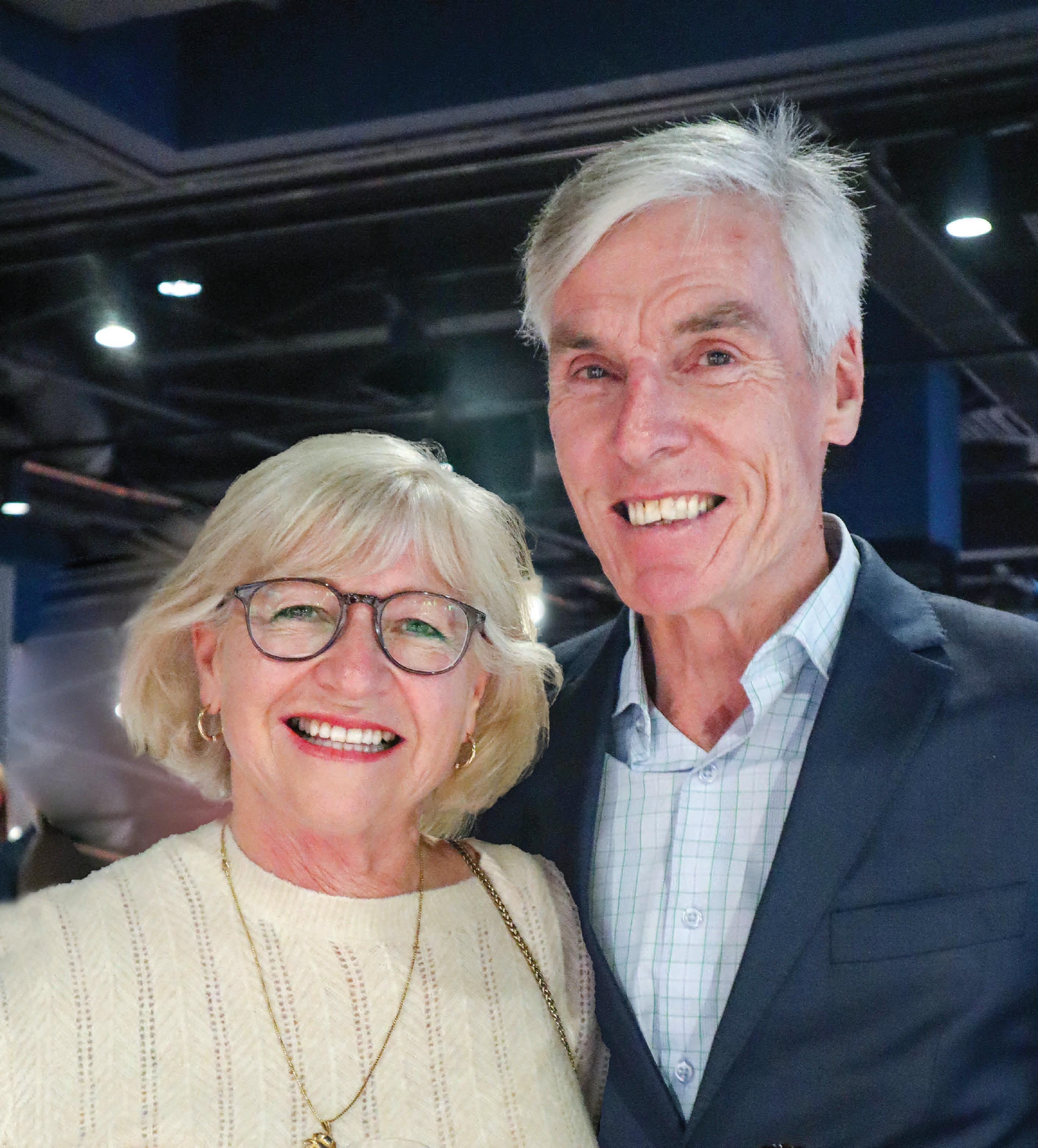


victorian / planning / environmental / law / association / volume 117 March 23
1
revue
E:
E:


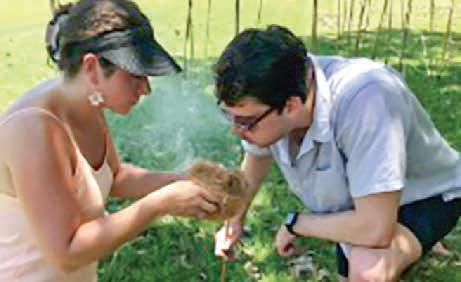
T:
T: 9813 2801
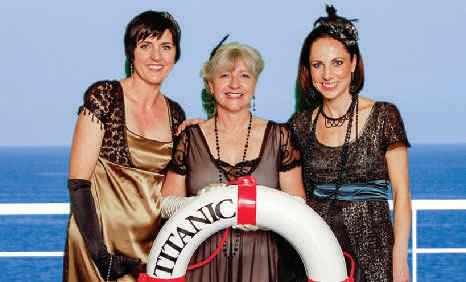
2 / VPELA Revue March 2023 Contents Seminars Design excellence 14 How well is the planning and environmental assessment process working for renewable energy projects in Victoria? 22 The Business Net Community Benefit, and Retirement and Aged Care Facilities 25 An Architect’s perspective 27 The Fast Lane 29 From your editors 3 President 4 People A new chapter for VPELA – Jane Power retires 6 Newly elected VPELA board members 7 Introducing you to the 2023 YPG Committee 9 Places NT ‘Walk on Country’ 12 Impacts of council decision making on community perception in growth area councils 19 Rory's Ramble 30 Cover:
retires
25
in December. Newsletter editors: Amanda Ring M: 0419 332 473 E: aring@upco.com.au T: 8648 3500
McFall
0459 321 020
Jane Power
after
years as Executive Officer and former Revue Editor, Bernard McNamara pictured
at the VPELA Christmas Party
Holly
M:
hmcfall@upco.com.au
Box 1291 Camberwell
8648 3500 VPELA PO
3124 www.vpela.org.au
admin@vpela.org.au
MELBOURNE
2
CENTRAL
DESIGN GUIDE
Welcome to the March edition of Revue
We open this edition by extending our thanks for the many good wishes that Holly and I received from members when we took on the editorial role in December. Bernard McNamara has left us with ‘big shoes’ to fill and we thank him for the generous and very helpful way he passed the baton to us.
Of course, you won’t observe a transformation in this edition, but we are hoping to change it up a bit in coming editions. We cannot do this alone and look to members for contributions and suggestions to ensure the periodical fulfils member expectations. Don’t be surprised, either, if we tap you on the shoulder for that article we know you’ve always been wanting or promising to write, but never have. We are also hopeful of receiving more contributions from professionals in disciplines which seem, at least on our review, to be under-represented.
2023 certainly seems to have got off to a busy start and we share your President’s optimism about the year ahead. We thank this month’s contributors for their articles and the various news ‘bites’ appearing in this edition. There is a range of material to get members thinking and talking including:
• Mark Sheppard’s report on last year’s Member Survey and the new Board’s work on preparation of VPELA’s 6-year Strategic Plan
• A recap of Jane Power’s retirement after more than two decades with VPELA.
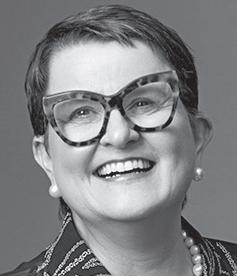
From your editors The new broom 3
• A precis of an interesting residential aged care facility matter planned and now approved in Mount Eliza, and the relevance of need.
• Some ‘takeaways’ from VPELA’s seminar on the assessment process for renewable energy projects in Victoria.
• An architect’s thoughts on the functional layout aspects of the Better Apartments Design Standards
• Henry Turnbull’s Fast Lane article on Clause 52.29 of the VPPs
• A Young Professional’s research piece that investigates the impact council decision-making has on community perceptions of performance in growth areas.
• A report on last year’s ‘Design Excellence’ Seminar.
• An uplifting reflection on VPELA’s inaugural and very well-received ‘Walk on Country’.
Fancy yourself as another Leunig?
Are you wanting to reveal another side of your personality?
Have you been hiding your sense of humour ‘under a bushel’?
Would you like to ‘chance your arm’ at cartooning?
Your editors are on the lookout for a member with a sense of humour willing to contribute to Revue from time to time. If we’ve piqued your interest, contact us to explore the opportunity further.
Letters to the editors
Revue is only as good as the contributions (mostly) made by members and, perhaps, its editors! A range of material is key to the publication but so, too, is feedback. Your editors are ‘chancing their arm’ with an invitation for feedback to report in future editions. Keep it to 45 words, or fewer, and we will aim to publish letters in a new (and hopefully, regular) part of Revue
VPELA Mentoring Program
The VPELA Board and the Young Professional Group recently launched a new mentoring program designed to bring new opportunities for members across disciplines to meet other members of differing seniority, and to discuss and share ideas on career aspirations and personal goals.
The success of the program relies on participants from both ends of the professional spectrum. We are confident that the Board and YPG will have many young professionals lined up and keen to be paired with a seasoned industry professional. If you want to be involved and share a wealth of experience with an eager youngster, be sure to get in touch.
We hope you enjoy reading this edition of Revue – we’ve certainly enjoyed putting it together for you.
Amanda & Holly
Amanda Ring and Holly McFall are part of the team at UPco –the Urban Planning Collective
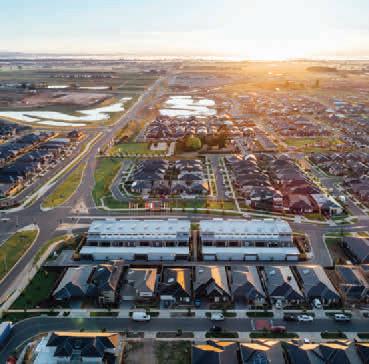

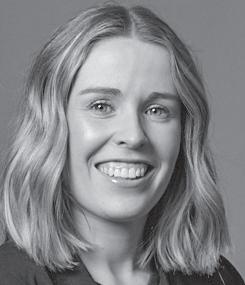
VPELA Revue March 2023 / 3
Amanda Ring and Holly McFall
President’s Column A changing of the guard
Welcome to the first edition of Revue for 2023. In contrast to the beginning of last year (which seems aeons ago!), and despite oncoming economic zephyrs, I sense a renewed mood of optimism and confidence in our industry. Covid anxiety is in the rear-view mirror and the opening of international borders is heralding a return to growth with the planning opportunities and challenges that come with it. Although the CBD may not yet have recovered to its pre-Covid intensity, a buzz is beginning to return. This was reflected in the big turnout for our Summer Drinks, which could barely have differed more from the modest outdoor gathering in Fitzroy Gardens at the same event a year ago.
Along with a return to a new kind of normal, the New Year marks a raft of changes to key positions at VPELA. While it is inevitably sad to see stalwarts of the Association hand over the baton, periodic renewal is critical to the health of any organisation, and the enthusiasm and acumen of the newcomers demonstrates the vigour of the Association.
New Revue Editors
This is the first edition of Revue for our new editors, Amanda Ring and Holly McFall. I’m delighted that they have taken on this important role and look forward to seeing what new directions they take the magazine in.
Bernard McNamara was the editor for seven years, during which time he consistently turned out a high-quality magazine and managed its transition to an online (as well as hard copy) periodical. Enormous thanks to Bernard for his long service to the Association, which includes many years on the Board.
New Executive Officer
Of the many changes mentioned here, none is bigger than the retirement and replacement of Jane Power, VPELA’s Executive Officer. Most of us have not known VPELA without Jane; she has been the heart and soul of the organisation for the last quarter of a century. On behalf of all members over that period, I extend the Association’s deep gratitude for her dedication, positivity and good judgement in shepherding the Association through significant growth and change. Personally, I cannot thank Jane enough for chaperoning this new President into the role!
Anna Aughterson has stepped into Jane’s role and was appointed following an exhaustive recruitment process. Although we can never replace Jane, I have no doubt that Anna will be an outstanding Executive Officer. If you haven’t had the chance to meet her yet, please introduce yourself at the next event.
New Board Members
At last year’s election, four new board members were elected: Lucy Eastoe, Damian Iles, Grant Logan and Emily Porter. They bring a wealth of experience from different disciplines and sectors, and are already contributing greatly to the Board’s work. Of course, this also means that four board members finished their terms: Cameron Alderson, Tamara Brezzi, Jonathan Halaliku and Liam Wilkinson.
Mark Sheppard, Principal, kinetica
VPELA would not exist without the extensive work undertaken by our volunteer board members. Thanks are extended to our retiring board members for their contributions and new board members for their commitment to the Association. In particular, I cannot thank Tamara and Cameron enough for the very meaningful contributions they made as President and Treasurer respectively.
New YPG Co-Convenor
Meanwhile, over at YPG, Jack Chiodo has stepped down as CoConvenor, a role he held for three years. Huge thanks to Jack for his leadership over this challenging period, and congratulations to Charlie Wurm for being appointed to the role alongside continuing Co-Convenor Izzy Vescovi.
New Minister for Planning
The Victorian Government has caught the winds of change and appointed a new Minister for Planning: the Hon Sonya Kilkenny. Congratulations to Sonya on her appointment. The Opposition has also appointed a new Shadow Minister, David Hodgett. With the ‘election dust’ settled, we are looking forward to engaging with them and a return of contributions to Revue in the June edition.
And finally…
The VPELA Board has adopted a new Strategic Plan, following our member survey and board Strategy Day last year. Thank you to all survey respondents for their valuable input. The main findings from the survey and key initiatives of the Strategic Plan are summarised in this edition.
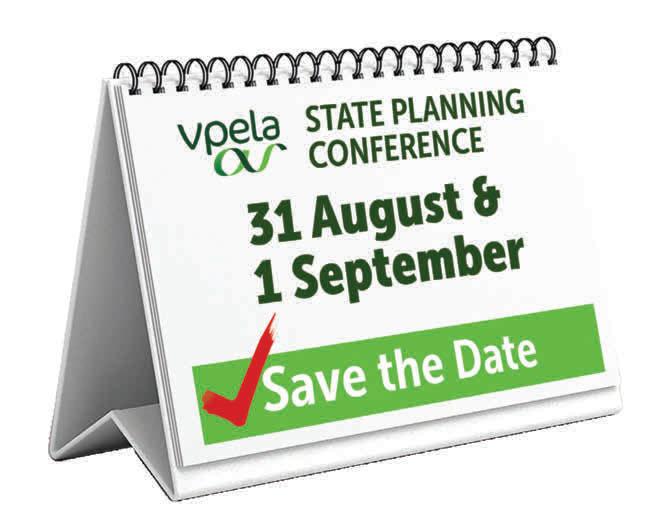
Continuing the theme of renewal, one of the key initiatives of the Strategic Plan is to complete and publish policies for the renewal of all positions relating to the Board, YPG and conference committee. Look out for those, and opportunities to get involved!
That’s more than enough renewal for one edition! I look forward to seeing you at our seminars over the next few months, and our annual Gala Dinner on 5 May.
Mark Sheppard is President of VPELA and a Principal at kinetica

4 / VPELA Revue March 2023
4
New Strategic Plan adopted by VPELA Board
The VPELA Board has adopted a new Strategic Plan to guide operations for the next six years. This draws heavily on the member survey conducted in September 2022, and a board Strategy Day held in November 2022.

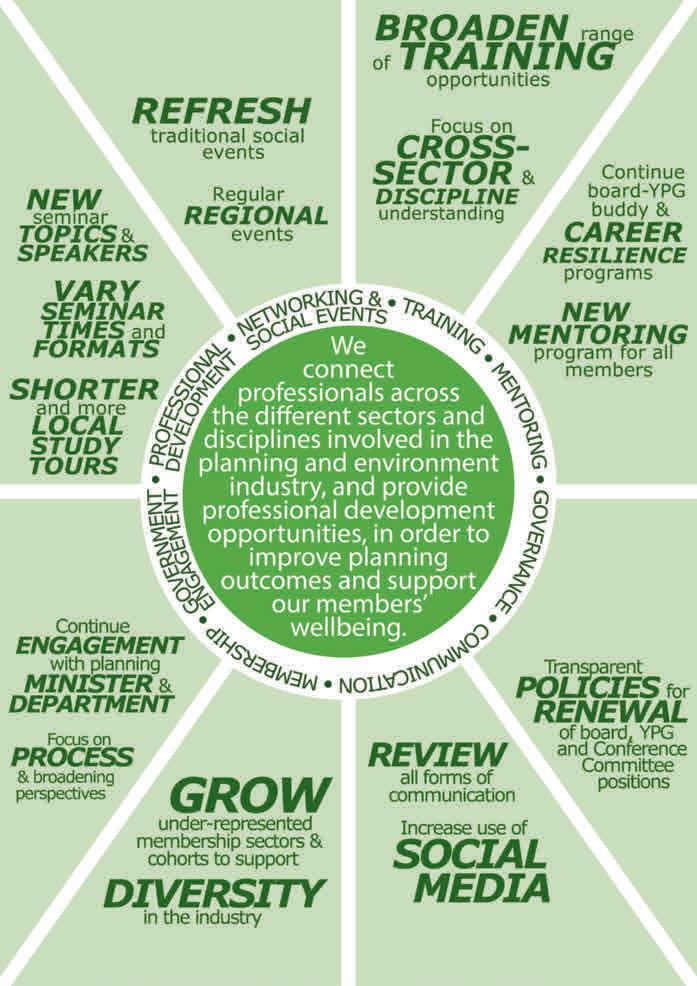
We received over 200 responses to the survey – enormous thanks to those of you who made the time to respond. The overall theme of the survey results was that the services currently offered are valued and address what members want from us. Pleasingly, the vast majority of respondents is satisfied with VPELA and believes the membership fee represents value for money. However, opportunities were identified to refresh the way we deliver our services.
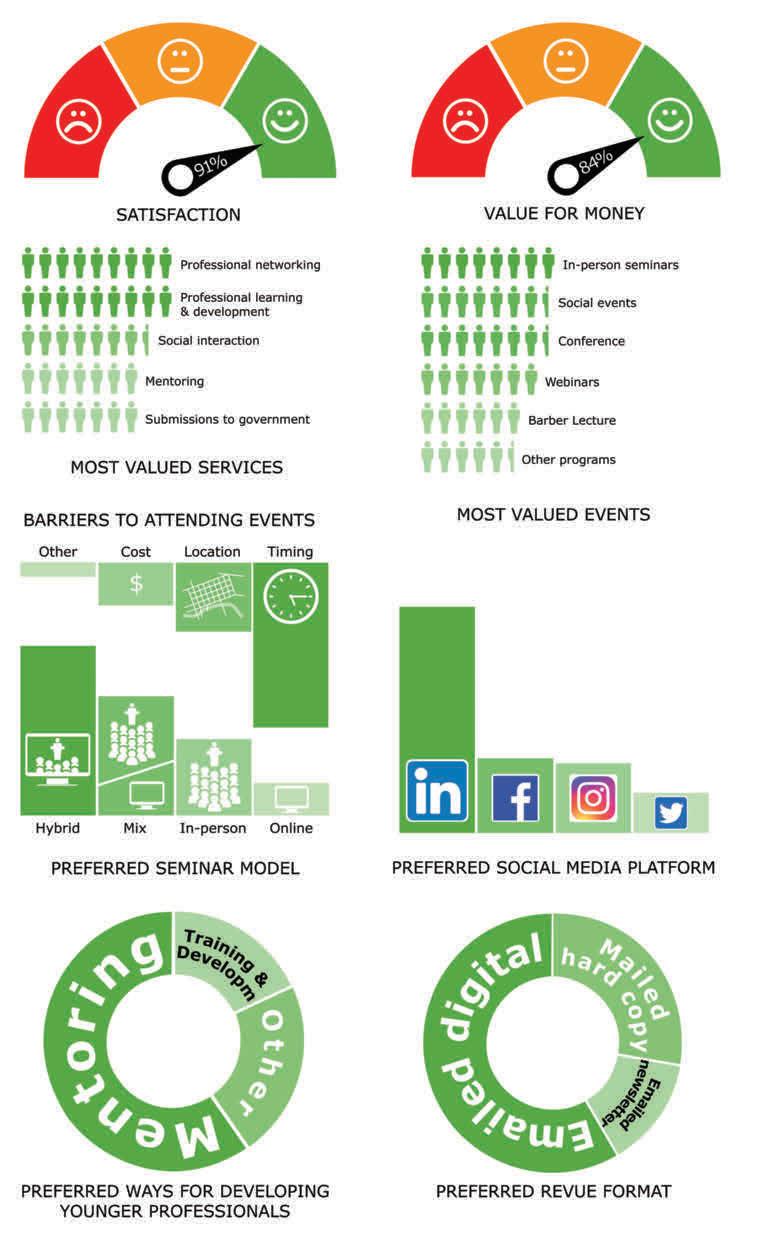
The key findings from the survey are illustrated in the figure below.
The Strategic Plan builds on these findings. In particular, it affirms our purpose, which is found below, along with key initiatives. The board and secretariat will now work to implement the Plan.
Of course, just because this is a 6-year plan, it doesn’t mean that you need to wait another six years before letting us know what you think! We will continue to conduct regular members surveys and, if you have any ideas or comments about what we do or how we do it, please get in touch with me or one of the other board members.
Thanks again for your support for VPELA.
VPELA Revue March 2023 / 5
Follow us on https://au.linkedin.com/company/vpela 5
A new chapter for VPELA
Jane Power retires
This is a transcript of the speech made by Tamara Brezzi, immediate past president of VPELA, at the Christmas Party last year.
You may have heard the news that our beloved Jane Power has decided after 25 years with VPELA to retire. She’ll be very uncomfortable about being the centre of attention for the next couple of minutes but we just couldn’t let the moment pass without acknowledging the incredible contribution that Jane has made over two decades.
When Jane started with VPELA she took on what was at the time a part-time largely administrative job. We think VPELA probably had around 300 members at the time and only ran a few events each year. Jane has been at the centre of VPELA’s transformation into the 1200 member strong, 40 event per year organisation that you know today. Her role is well and truly more than full time and together with Grace and many other staff that she has looked after over the years, she has overseen thousands of seminars and events, as well as 24 annual dinners and conferences.
There’s nothing that Jane doesn’t know about VPELA. Kathy Mitchell jokes that she only ever had one argument with Jane every single year – and that was about the theme for the annual dinner. And each year Kathy would lose and Jane would reassure us that it would be great and it always was.

Jane has a particular talent and love for pulling together big events like the dinner and the conference and I’m sure you’ll agree that she is very, very good at it!
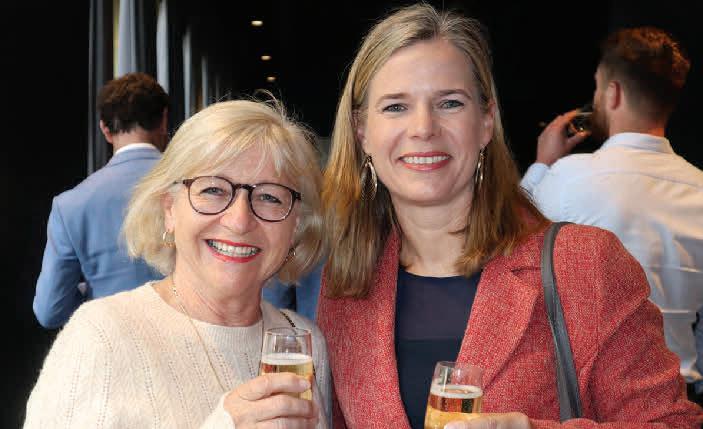
For me, Jane counselled and supported me throughout my entire Presidency and while many have asked me what I’ve been doing with all my spare time since I stepped down from that role in February, I’ve been able to confidently reply that the role was never a burden and that can be largely attributed to the dedication that Jane has given her role and the professionalism with which she pursued her career with us.
At the start of the pandemic, Jane and I sat down to ask ourselves how on earth VPELA was going to survive if we couldn’t run in-person events and she confidently worked with the Board and I to transform VPELA into an online and in-person organisation with hardly the bat of an eyelid.
Tamara Brezzi, Immediate past president, VPELA

Jane, on behalf of Kathy and myself, Mark and all the other presidents you’ve worked with, and all the members of VPELA, thank you. You’ve been a warm, generous, talented, fun, colleague and you can be extremely proud of all that VPELA has achieved under your leadership. We’re obviously going to miss you terribly. Please join me in thanking and congratulating Jane on her retirement.
Welcome Anna Aughterson
VPELA is pleased to welcome Anna Aughterson as the new Executive Officer for VPELA. Anna has a Bachelor of Arts (Public Relations) and Master of Arts (Communication) from RMIT and has nearly 30 years’ experience working in communications and event management, mainly in an education setting. The majority of this experience was 17 years at Ivanhoe Girls’ Grammar School where she managed the Public Relations department and was heavily involved in the marketing and promotion of the school. This included organisation of Open Days, school tours, building openings, parent seminars and various social events. In addition to event management, Anna has worked extensively with Boards and volunteers and supported these groups as well as coordinating advertising and printed and online marketing. She is keen to use these skills as well as her relationshipbuilding skills to support the VPELA membership with its goals of facilitating professional development, promoting knowledge and providing networking opportunities.
Anna is looking forward to meeting and getting to know the VPELA members over the coming months and supporting the Association into the future. In her spare time Anna enjoys spending time with her family and is kept busy with two daughters – one doing Year 12 this year and the other starting Year 7. She enjoys travelling, good food, catching up with friends, walking her boisterous 10-month-old Golden Retriever, Harley, and watching her girls play netball. She is also passionate about Melbourne property and has renovated, built and undertaken a small development project so has a keen interest in the industries that VPELA represents and is eager to learn more about what our membership wants out of its association.
6 / VPELA Revue March 2023
Tamara Brezzi is a Partner at Norton Rose Fulbright and former President of VPELA
People
6
Soha Refaat, Jane Power and Grace Hamilton at Galactic Gala Dinner in 2018 Jane Power and Anna Aughterson, newly appointed Executive Officer of VPELA
Grant Logan, Department of Transport and Planning
Grant has been an active member of VPELA since the start of his planning career in 2004 and joined the Board in October 2022. Since starting a role as a Student Planner with Ratio Consultants in 2004, he’s taken on a number of roles in government (both local and State) and private practice with a strong emphasis on VCAT, providing ongoing advocacy and evidence in this space. He joined DELWP (now DTP) as a Manager in the Development Approvals and Design team in August 2021, taking on a team that is responsible for overseeing major projects in Fisherman’s Bend and Central Geelong. The various positions he’s held in State and local government, as well as private practice, have given him a nuanced appreciation for the opportunities and challenges which define our work as built environment professionals. He is most interested in the connection between people and place, and urban renewal areas. He really enjoys working in the two areas his team is responsible for at DTP, and believes we have a unique opportunity to help shape liveable and thriving neighbourhoods.


He has always believed that VPELA has provided significant and invaluable professional opportunities (including the Moot Court, seminars and the conferences). However, the most rewarding elements of the organisation for him have been the networking opportunities and the ability to build good relationships with a range of professionals that operate in the industry. He respects the fantastic job VPELA does to bring people together and ensure lasting relationships that foster collaboration across disciplines that come under the VPELA umbrella.
Outside work, he tries to get outdoors as much as possible and has spent most of his life savings travelling and seeing far flung parts of the world. He is hoping to combine his love of hiking and trail running over the next few years to do some more exploring. He is probably most excited to see Geelong win another flag this year or perhaps a three-peat!
In addition to working together with a diverse group of professionals in the industry, he welcomes the opportunity to be a Board Member to advocate for greater State Government representation and to help promote greater involvement of State and local government employees in the organisation. His focus will be on highlighting the extensive professional and networking opportunities that VPELA provides and to encourage increased membership of the public sector. He sees the advantage of this to be stronger relationships between public and private, resulting in more collaboration and improved outcomes for planning in Victoria.
Emily Porter SC, Victorian Bar
People Newly elected VPELA board members 7
Emily has been practising planning and environment law at the Victorian Bar for over 15 years. She joined VPELA as a member in 2008 and the VPELA Board in 2022. Emily appears on behalf of developers, State and local governments, State government entities and community groups in VCAT, Planning Panels Victoria, the Heritage Council and the Supreme Court in planning, environment, compulsory acquisition and valuation matters. The best part of her job is arguing about how the future should look, and doing site inspections of places that are otherwise inaccessible to the public.
Emily is keen to foster closer ties between VPELA and the Bar, and to mentor junior practitioners, particularly those trying to balance work with parenting responsibilities. When not working, you’ll find Emily at the beach with her two dogs, on a yoga mat, or online shopping.

Damian Iles, Director, Hansen Partnership
Damian is a Planner and Expert Witness with over 25 years’ experience in the Victorian planning system. He is a longstanding Director and (recent) Governing Board Member of Hansen Partnership, a multidisciplinary planning and design practice working across the public and private sectors. He joined VPELA in 2004 and is a current VPELA State Planning Conference Committee Member.
Damian has been at Hansen for over 22 years. Much has occurred during this time that has allowed him to pursue things he’s passionate about and work with a team of professionals on the things that matter. These include alternative and innovative housing models, as well as the longevity and sustainability of housing design. He also really enjoys working with Melbourne’s leading architects as agents of change and is immensely proud of his contributions, work and associations with a range of not-for-profit organisations including Nightingale Housing, Housing Choices Australia and Launch Housing.
He has actively contributed to VPELA through the State Planning Conference, by organising keynote addresses on architecture, design and heritage the genesis and merits of Nightingale Village in Brunswick – and the claim that Rock and Roll Ain’t Noise Pollution, focusing on The Tote (Hotel) and the need to protect live music venues via agent of change policy.
…continuesnextpage
VPELA Revue March 2023 / 7
Damian loves the culture of Melbourne, its tribal football territories, its laneways, parks, waterways, cafes and sticky carpeted band venues. These things underpin its social fabric. He knows it is a privilege to work within this space and to deliver great places for its people. Outside of practice, you will find him spending time with family and friends. He likes to stay active and doesn’t rest easily!
He flocks to the MCG in hope of elusive success for his beloved Magpies. He also follows what the wind and swell is doing to escape the city and place himself in semi-crowded longboard surf breaks when he can. He also keeps a watchful eye on where he can catch local and international touring artists and bands. Otherwise, he has a small group of running mates who banter and bicker about who has the greater footy prospects on any given season and how on earth Patrick Cripps escaped sanction by the AFL Tribunal in season 2022.
He has two kids, both teens. One is a 13-year-old son, who is always in perpetual motion and likes nothing more than throwing himself into new activities including skateboarding, tennis, cricket, table tennis, basketball, Xbox and (more recently) chess…he is yet to understand the value of his Queen! His daughter is 15 going on 25. She is strident, passionate, very kind and a chronic list-writer. She suffers from perfectionism and is very task-oriented. She has no interest in competitive sport but loves music and the arts, is an avid reader and has a well-calibrated social consciousness and deep care for our environment. She could be a planner, but is wary of following her dad's path. He may encourage her anyway as its going to be a far easier work experience option for a Year 10 parent!
As a family, they hang out at home in Brunswick. It’s a special place which started off as a Hansen project with Six Degrees Architects. Since the time they moved in 2011, Heller Street Park and Residences has helped influence his passion in alternative housing, and social and environmental sustainability. It's living proof that density can be done well and that getting alignment within community can be a very rewarding way to live.
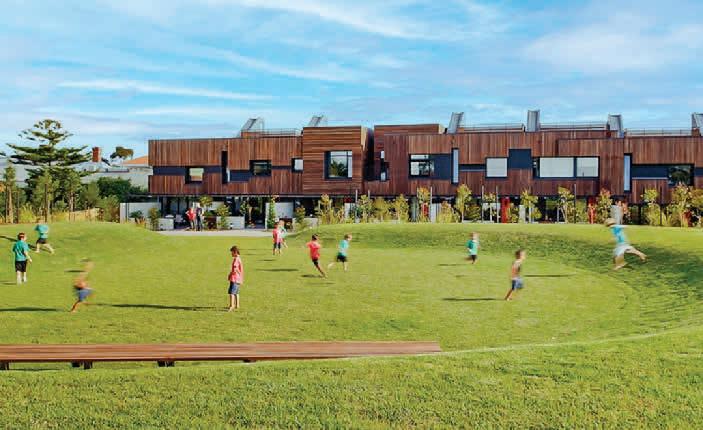
He’s excited to have been elected to the VPELA Board, knowing it's a privilege and an opportunity to impact our industry, its direction and topics we bring to the attention of our members. He looks forward to engaging with the association and to opportunities that lie ahead. Go Pies!
Lucy Eastoe, Arnold Bloch Leibler
Lucy, a Senior Associate, is a planning and environment lawyer with 15 years’ experience in the industry. She is part of the select and special group of legal practitioners who has both town planning and legal qualifications.

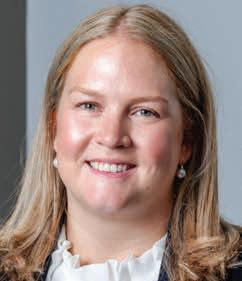
Lucy is often asked what her dual qualifications bring to her practice, and whilst it is not easy to express in words, she would say that being a lawyer makes her a better planner and being a planner makes her a better lawyer.
Lucy grew up in regional Victoria in the township of Mildura. Mildura is in north-west Victoria on the banks of the Murray River – the Murray forming the border with New South Wales. For those members of the VPELA community who are yet to visit the Sunraysia Region, Lucy conveys that the 5 hour drive (or 1 hour plane ride) is worth the trip for some great scenery, food and of course the people!
The lack of planners in regional Victoria was what drew her to the planning profession initially. Her career has kept her in Melbourne, but she enjoys the fact that her planning practice is diverse and includes both regional and metropolitan work. Whilst she really is a city dweller at heart, she has never forgotten her regional roots.
Having undertaken her planning studies at RMIT University, Lucy benefited from the workplace component of the course and began her planning career at the City of Stonnington. A bout of glandular fever stretched the 60-day work placement out over several months and, from then, Lucy was hooked on planning.
She has had many career highlights and many great mentors during her time with John Glossop at Glossop Town Planning and later Best Hooper Lawyers. These days you will find Lucy at Arnold Bloch Leibler doing what she loves best: anything planning-related. She continues her love for appearance work at the Tribunal and Planning Panels, but also loves working with her property colleagues to achieve great outcomes for her clients.
Outside of work, Lucy loves to travel and she is looking forward to more overseas travel in the coming years. She is also an avid football fan, although her attendance at the MCG is usually more in a social capacity. She enjoys the “G” so much you will often find her walking her dog around Yarra Park after work. Lucy is also a member of the Women of the Melbourne Cricket Club Committee. This committee aims to further the participation of women in sport and was founded by another member of the planning and VPELA fraternity, Jane Nathan.
Lucy is a long-standing member of VPELA. Her attendance at its seminars, conferences and annual ball have been highlights for her professionally and also personally. Lucy is excited about the future of VPELA and looks forward to giving back to an organisation she has gained so much benefit from in the past. She is particularly keen to further the strategic work that has been undertaken by her board colleagues and which follows the recent VPELA membership survey.
Friday 5 May Bookings Now Open!
8 / VPELA Revue March 2023
Thanks to our major sponsor Villawood Properties and all ouR table sponsors
8
Heller Street Park and Residents, Brunswick
Introducing you to the 2023 YPG Committee
Isobell Vescovi (Convenor)

Izzy is an Associate at Urban Planning Collective (UPco). A problem solver by nature, she works on a range of planning matters and particularly enjoys the strategy and negotiation aspects of her day-to-day work.





Outside planning, you’ll find Izzy at the gym, walking, running and exploring the newest bars and restaurants on Smith Street. This is Izzy’s second year as Co-Convenor of the YPG.
Charlie Wurm (Convenor)
Charlie is an Associate in the Public Law team at Maddocks. He works on a broad range of planning and environmental matters, and regularly appears as a solicitor-advocate before VCAT, Planning Panels Victoria and the Magistrates' Court of Victoria. Charlie also maintains a broad practice in prosecution and enforcement matters.
Outside work, you will find Charlie running, regurgitating quotes from The Simpsons and supporting Carlton. This is Charlie’s first year as Co-Convenor.
Zac Van Grondelle
Zac is the Coordinator of Statutory Planning at Surf Coast Shire Council. Experienced in a wide range of major development, and urban and rural applications from his time working in both metropolitan and regional councils, Zac is a customer and outcomefocused planner.
Outside work, Zac spends as much time as possible exploring all things Geelong and the coast have to offer – now accompanied by two rescue greyhounds, Frog and Trixie.
Amara Coleman
Amara is a Senior Associate in the Planning and Environment team at Harwood Andrews. Amara works across a variety of matters involving statutory planning, strategic planning, environment protection and local government. Amara enjoys the nuance and complexities of planning and environment matters and the opportunity to collaborate with, and learn from, industry colleagues with different expertise.
Outside work, Amara is endeavouring to cultivate a garden (with mixed results) and otherwise keeps herself busy with Pilates, cooking as many Ottolenghi recipes as possible and walking her dog, Lou.
James Cossins


James is a Senior Traffic Engineer at Traffix Group. He has experience across a wide range of land use and development proposals from small- scale residential developments to town centre and major retail developments. This is his second year on the YPG Committee, and he is looking forward to 2023.

Outside work, James enjoys heading down the coast, going to the football to support the Saints and getting in a round of golf, or two, or three...
Emily Mignot
Emily is a Senior Town Planner with Tract Consultants. Having worked across local government and consultancy in both planning and engagement, she has a well-rounded understanding of planning from both statutory and strategic perspectives. Fascinated by the inclusive nature of decision-making in Victoria, Emily believes that the planning and built environment industry has a leading role to play in shaping the next chapter of our ever-changing world… for the better!
When not immersed in planning and development, Emily is passionate about the arts, as well as issues related to the environment and geopolitics and, most importantly, can’t wait to be part of the YPG for another stellar year ahead!
Michael Pavlidis
Michael is a Lawyer in the Planning and Environment team at Rigby Cooke Lawyers. He is passionate about planning, property, environmental and administrative law and enjoys contributing articles to Revue when time permits.

Outside work, he enjoys hiking, going to the footy and travelling. This is Michael’s third year on the YPG Committee.
Madeleine Craig
Madeleine Craig is a Senior Planner at Hansen Partnership and this is her second year on the YPG Committee. Professionally, she is driven to deliver exceptional planning outcomes with quality and sustainability in mind. Her work is predominantly focused on Melbourne’s inner suburbs and, in 2023, she is excited to expand her portfolio of work to include more social and affordable housing projects.
In her free time, Madeleine enjoys running, bouldering, and exploring Melbourne’s ever-evolving food and drink scene.
Amy Najarialamouti
Amy is an Urban Designer with over five years of experience (including two years and eight months of experience gained abroad). She is currently part of the team at Taylors Development Strategists and grateful to be a part of a very friendly and inspiring practice. Amy is mum to 21-month-old, Hannah. Outside work, she enjoys travelling and spending time with Hannah and her husband.
Briony Oddey
Briony is a Paralegal in the Planning & Environment team at Hall & Wilcox and, in a few months, she will take up a role as Lawyer with the firm. During her time at Hall & Wilcox, she has assisted the team with numerous matters acting on behalf of private sector clients and local and State governments in both planning and real estate matters.
Outside work, Briony enjoys adventures with her family, eating delicious food, and drinking a drop (or two) of gin.
VPELA Revue March 2023 / 9 People
9
Dinan McMahon
Dinan is a Graduate Planner at Cogency Australia, a climate-focussed planning consulting firm. His major focus is on the GIS side of planning; producing maps for a range of urban and regional projects. Dinan enjoys working in the renewable energy space and is fortunate to be working on a variety of solar, wind, and energy storage projects across Australia. He is passionate about the role planners have in reducing emissions and transitioning our economy to carbon neutrality.
Outside work, Dinan enjoys the outdoors, playing and watching sports, and discussing public and active transport.


Tom Morrison
Tom is a Lawyer at Planning & Property Partners and works in all areas of planning and environment law. He has experience with planning applications, as well as VCAT appeals and Planning Panels Victoria where he acts for both developers and landowners.


Away from the office, Tom is an active surf lifesaver and keen outdoorsman who enjoys being constantly on the move.

Bridget Goodear
Bridget is a Town Planner at Beveridge Williams. Bridget’s experience ranges from preparing site feasibility assessments to providing strategic planning advice and advocacy submissions on behalf of clients. Bridget has a keen interest in planning for residential estates in Victoria’s growth areas.


In her spare time, Bridget enjoys travel, and spending time with friends and family. This is Bridget’s first year on the YPG committee.
Dani Davidovits
Dani is a Lawyer in the Environment and Planning team at Minter Ellison. Dani regularly assists clients with a range of environmental regulatory matters spanning across the retail, mining, renewable energy, waste, and public sectors. Dani enjoys the dynamic nature of environment and planning law, assisting clients to navigate a changing legal landscape, and the continuous learning that comes with working in an industry that always keeps you on your toes.
Outside work, Dani is a lover of musical theatre, watching (but not playing) tennis and discovering new recipes. This is Dani’s first year on the YPG Committee.
Caroline Graham
Caroline is an Associate Town Planner at Tract. She is involved in a range of statutory and strategic planning matters and has a particular interest in precinct planning for urban renewal sites. Her projects span Victoria, Tasmania and South Australia, and include residential, commercial, industrial and tourism uses, and many in between.
Outside the office, Caroline can be found on her bike, walking with her dog or cooking up a storm.
Joshua McLennan
Josh commenced his planning career at Biosis but has recently joined HIP V. HYPE in the Better Cities and Regions Team. His experience includes statutory planning, strategic planning and environmental impact assessment throughout Victoria and New South Wales. Josh is particularly interested in the way planning can be used to balance environmental preservation with the needs of a growing population.
Outside work, Josh enjoys camping in Western Victoria, enjoying a gig in Melbourne and heading down the Great Ocean Road with his dog, Leo.
Felicity Karakiklas
Felicity is a Town Planner at Contour Consultants. Felicity works on a variety of planning matters, including residential, mixed use, industrial, retail and commercial developments of all scales.
She is results-driven and passionate about delivering positive and innovative planning outcomes. This is Felicity’s first year on the YPG Committee, and she is looking forward to what the year will bring!
Outside work, Felicity is a passionate Carlton supporter, enjoys travelling, cooking (and eating) delicious food and spending time with family and friends.
Adam Gardiner
Adam is a Project Engineer at One Mile Grid with four years’ experience in traffic engineering, transport planning and waste management planning. He has experience in a broad range of commercial and residential developments, from small-scale residential projects to greenfield industrial estates.

Outside work, Adam enjoys eating a pub lunch, listening to podcasts and hitting the slopes in winter.
James
Aloi
James is a Traffic Engineer at WGA. He works on a variety of different traffic and transport-related projects including residential, commercial and industrial developments, primary and secondary schools, shopping centres, hospitals, hotels, major road infrastructure projects and more. James is passionate about building client relationships, providing excellent service and delivering high-quality work.
Outside work, James is a keen follower of the NBA. He is also a longtime St Kilda su(fferer)pporter, part-time kitchen DJ and explicitly listens to bangers.

A message from your Young Professional Group Co-Convenors
2022 was a successful year for VPELA’s Young Professional Group, heralding the return of in-person seminars, events and social networking functions to great success. Each event had a strong focus on building valuable industry connections and we managed to achieve record attendance at many of our events. It was great, too, to see so many new faces.
10 / VPELA Revue March 2023
10
In 2023, the YPG is looking forward to hosting many more insightful seminars, alongside our suite of more casual events to meet fellow professionals and make new friends in the industry. With the turn of the new year, we would like to thank outgoing CoConvenor, Jack Chiodo, and our outgoing Committee members –Stephanie Cimino, Jack Curnow, Teresa Davis, Lina Inglis, Charlotte Phillips and Zina Teoh – for their commitment and great contributions to the YPG in recent years. On the flip side, we have introduced the fresh faces who join our Committee for 2023 (including a change of leadership) and we are excited to see what each will bring to the YPG in the year ahead. Welcome aboard!



This year, we are particularly eager to bolster the involvement of students at our seminars and events which provide valuable opportunities to meet fellow members and engage with the industry. We urge all workplaces to assist their students and graduates to come along to our YPG functions. With this goal in mind, we will be exploring a number of new initiatives and ways to engage, interact and learn – so watch this space for some exciting announcements throughout the year.
We can’t wait to see what 2023 holds for us!
Your YPG Co-Convenors, Charlie and Izzy, on behalf of the YPG Committee.
YOUNG PROFESSIONALS AWARD 2023 $5000 GRANT



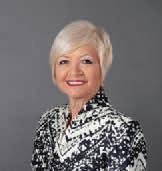






VPELA is pleased to invite applications for the VPELA Young Professional’s Award for 2023. This highly prestigious award is open to VPELA members between the ages of 18-35, who have been members of the Association for at least 12 months. The Award includes a trophy and cash grant of $5000 to support the recipient in undertaking independent research (domestic or international), or a course of study related to their industry, as well as opportunity to speak at our Fellows Dinner in 2023.











For details of qualifying criteria and an application form please contact Anna Aughterson, VPELA secretariat on 9813 2801 or download them from the awards section on our website www.vpela.org.au
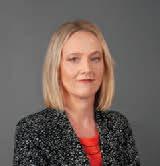


Applications close Friday 31 March 2023
Proudly sponsored by

VPELA Revue March 2023 / 11
Environmental & Planning Law Barristers (03) 9225 7777 foleys@foleys.com.au For assistance, reccommendations & bookings, contact Foley’s Clerking Team: • VCAT • Planning Panels • Local Government Matters • Supreme Court • Mediation • General Advice Available For:
11
Places NT ‘Walk on Country’
Angela Ash was born and grew up on Gunaikurnai country and is now living and working on Bunurong country. Lewis Moore was born on Larrakia country before moving to Bunurong country where he grew up and now lives.
The rich storytelling history of the world’s oldest living culture is what we proudly pay tribute to in sharing stories of our walk on Larrakia country.
This story began in late October 2022 when an eager and energetic group of us made the trip north to Darwin for the inaugural ‘Walk on Country’ organised by the Tjungu Project. However, before we left Wurundjeri country, we were asked to be open to the experience and take it all in with open eyes, minds and hearts.
Early in the experience, the group attended a ceremony where we were welcomed by the traditional custodians of Darwin and its surrounds, the Larrakia. The Larrakia are known as ‘Saltwater people’, whose traditional lands occupy the coastal area around Darwin.
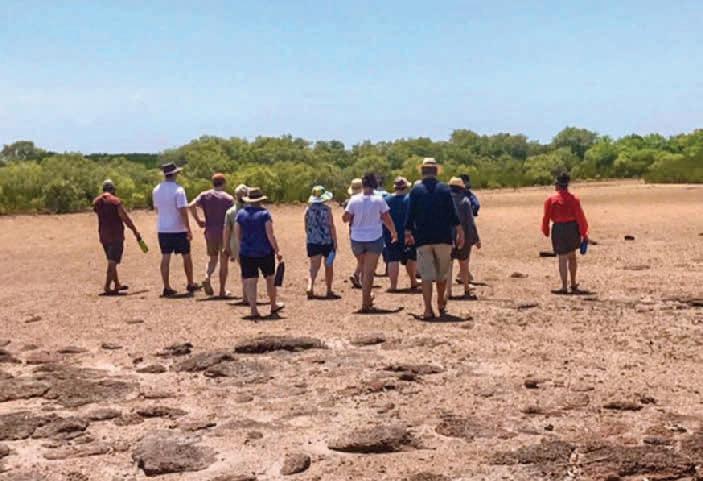
Having safely made it clear of the water (and crocodiles), there was an overwhelming sense of peace amongst the group as we watched the sunset light up the skyline across the water. It was a privilege to receive this welcome directly from the Larrakia, who have occupied and cared for the land for over 50,000 years.
12
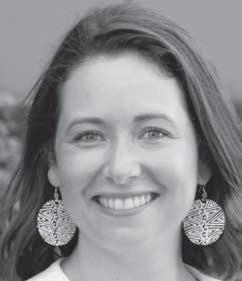
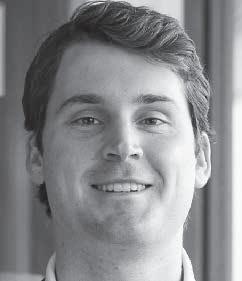
In addressing the group at the welcome ceremony, there was a feeling of apprehensiveness and even nervousness held by senior members of the Larrakia towards us, just as there is with meeting any stranger and welcoming them into your home. By the end of the trip, this feeling seemed to have dissipated, as every individual received a personalised farewell throughout the smoking ceremony. This gesture left us not only feeling very spiritually at peace, but let us know that our participation in the broader cultural learning experience, and the way we approached it, was appreciated.
In reflecting on our time on Country over the past few months, the interactions with the Larrakia people we were priviledged to meet, engage with and learn from, and places we visited (such as unmapped local sacred sites) all shaped our own personal experiences of our time on Country.
Source: The Larrakia Development Corporation (https://www.larrakia.com.au/)
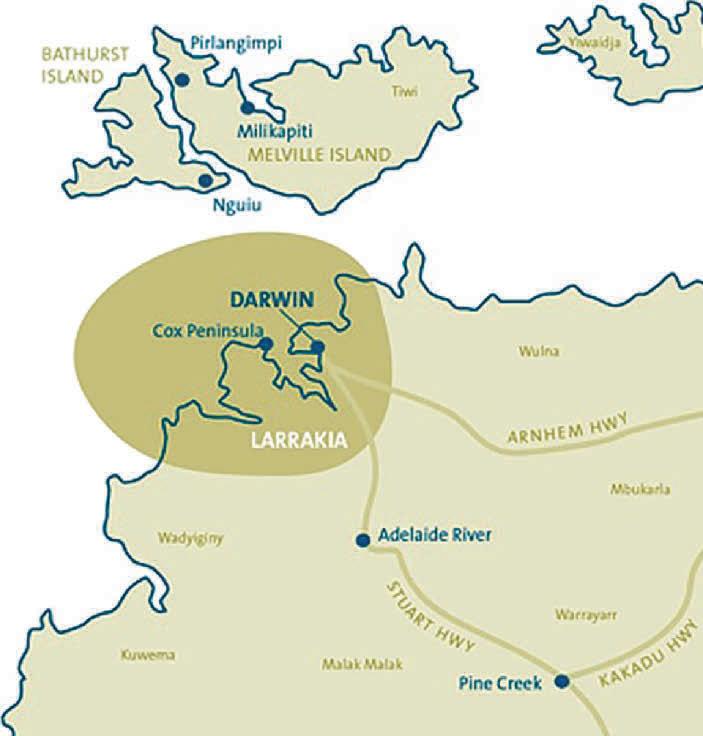
Fittingly, the welcome ceremony was held at what is now known as Mindil Beach where we were greeted by ‘Aunty’ Leslie (Larrakia elder), Trent (Larrakia man), Mark Motlop (Chairman, Larrakia Development Corporation) and Nigel Browne (CEO, Larrakia Development Corporation).
Using the analogy of ‘knocking at the door before you enter a host’s home’, Trent encouraged us to take the salt water in our hands and rub it on our skin to let Country know that we had arrived. For fear of crocodiles, we cautiously waded into the shallows and proceeded to ‘knock on the door’.
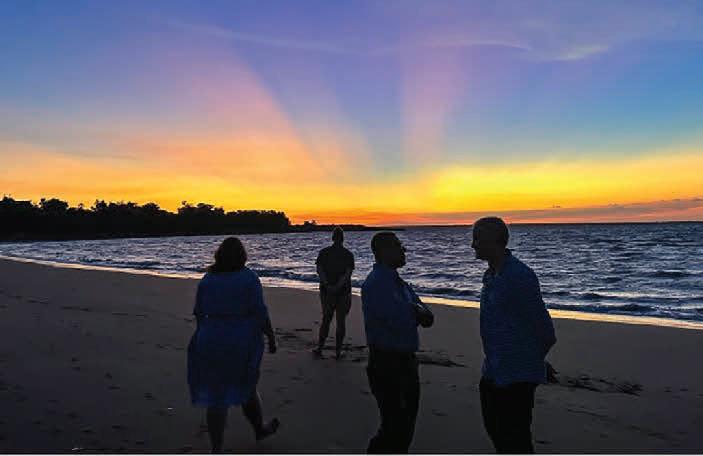
12 / VPELA Revue March 2023
Lewis Moore, Ratio Consultants
Angela Ash, Bold Urban Planning
Walk on Country Larrakia
Sunset, Larrakia
Each of the people we met on our journey on Country were open and welcoming of us, and extended such genorisity in the way that they shared their culture and cultural practices with us. The direct and personal engagements with culture and people, on reflection, had a lasting personal impact on each of us.
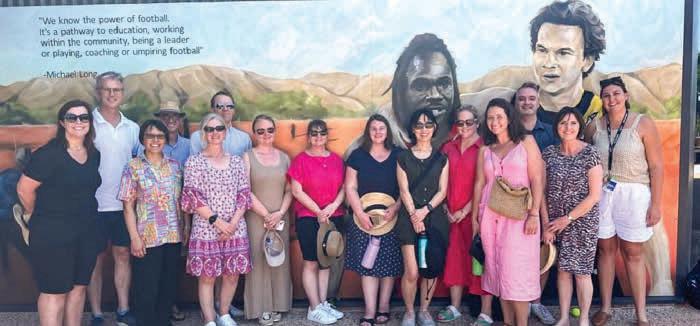
We were in awe and deeply inspired by those we met along the trip including Uncle John, Aunty Leslie, Aunty Naomy, Michelle Kerrin, Sorelle Ashby and Timmy Duggan. Each shared so much of their self with us and provided us with a personalised understanding of what their culture means to them but also the challenges faced both in the past and in the future. These discussions sparked more questions than it gave answers, which is perhaps both a fundamental part of the journey of growth that we have embarked on as part of the Walk on Country and an attempt to be better allies of the Indigenous people of this land.
It was also explained to us that football offers a sense of purpose to young Aboriginals, particularly throughout the football season when statistically, rates of alcoholism among Indigenous Australians is lower than the off-season.
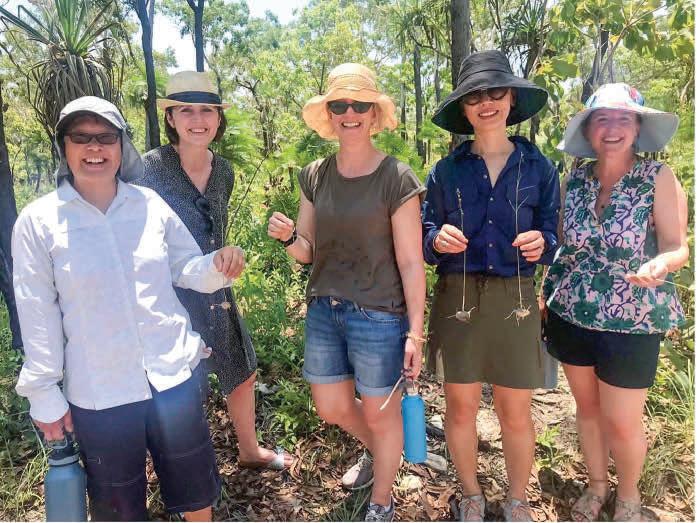
The importance of sport in Indigenous life and culture was further emphasised in the discussions with Sean Bowden and Michelle Kerrin at the Michael Long Learning and Leadership Centre and in turn the presentation by former professional basketballer, Timmy Duggan who was the first Aboriginal man to play in the NBL. Duggan, who founded the ‘Hoops 4 Health’ program, shared his journey which now sees him visit youth detention centres and other juvenile rehabilitation facilities with the goal of improving the lives of young Indigenous Australians through basketball and exercise. This speaks to the values associated with sport, which acts as a vehicle for positive change in the lives of Indigenous Australians, harnessing a sense of structure, discipline, and togetherness in the community.
Our time on Larrakia Country was bookended by the Welcome to Country ceremony that took place on our first night and the smoking ceremony before leaving for Naarm. We were so deeply moved by these experiences because of the open and heartfelt way that Larrakia culture was shared with us and to be welcomed onto the land – not just for the duration of the trip, but forever. At the smoking ceremony, there was a tranquility but also a sadness to be leaving Larrakia Country and the incredible Larrakia people who had such a profound impact on us. As allies, who all share a passion and interest in Indigenous culture, the engagement we had with Larrakia was reaffirming in letting us know that through an improved understanding and, in turn, greater respect for Indigenous culture we can play a part (however small) in the pathway towards reconciliation.
Another recurrent theme was the important role that sport plays in indigenous culture, particularly that of (‘Aussie Rules’) Football. From the first day in visiting the Wurrumiyanga museum on the Tiwis, the Michael Long Learning and Leadership Centre, to attending a St Mary’s Football Club game at Marrara Stadium, it was evident that football provides a sense of pride to Indigenous Australians, who are well represented amongst the game’s greatest players and most renowned figures.
Football is also regarded as the ‘glue’ that binds Indigenous and nonindigenous culture together in a game that has been influenced by all sections of Australian society. In modern Australia where there is much division in socio-political discourse on Indigenous affairs, such as whether to ‘change the date’ or the importance of ‘closing the gap’, this notion of being united in sport is an important one.
We left with a feeling of deep connectedness with Larrakia Country and the people we were lucky enough to meet along the journey. We would like to extend our thanks and gratitude to VPELA (in particular Peter O’Farrell and Mark Sheppard) together with Kane Bowden and Mitch Brown at the Tjungu Project for providing us with the opportunity to participate in the first Tjungu Project Walk on Larrakia Country.
If another Walk on Country is organised for 2023, we strongly encourage you to participate as it is a once in a lifetime experience. We hope, in turn, that you can share your own personal experiences with others that will perhaps provoke further questions and interest in Aboriginal culture and the role that we, as non-Indigenous peoples, can play as meaningful allies.
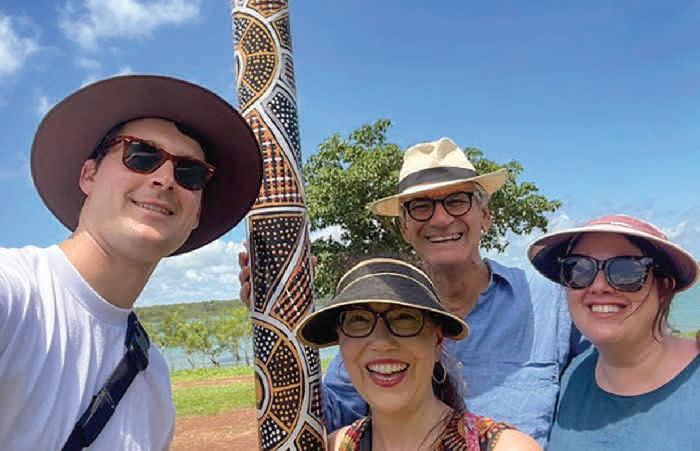
VPELA Revue March 2023 / 13
Angela Ash is a Director at Bold Urban Planning and Lewis Moore is a Senior Planner at Ratio Consultants
Liz Hui, Grace Hamilton, Jodi Kennedy, Linda Choi and Sarah Carlisle foraging on Larrakia Country
VPELA Walk on Country Group pictured at the Michael Long Centre Learning and Leadership Centre
13
Lewis Moore, Meredith Gibb, Tim Biles and Mia Zar on the Tiwi Islands
Seminar Design excellence
Is acceptable no longer good enough?
On 24 November, VPELA welcomed 70 members to a rare in-person seminar hosted by Marjorie Kennedy at the offices of Colin Biggers & Paisley. At the event, a panel of experts wrestled with the notion of Design Excellence and its place in our built environment. The night was attended by members from a variety of fields, including Tribunal and Panel members, planners, designers and lawyers joining their local government colleagues in conversation around Design Excellence.
The panel was made up of experts from both sides of the fence with Yogeshwari Biju speaking to her experience as a decision maker with the City of Casey and the Design Excellence Network (LGDEN), while Daniel Soussan (Tract) and Cian Davis (Bates Smart) gave insights into their experience as consultants and designers involved with design review panels.
Yogeshwari opened the discussion with a deep dive into how our local governments are pushing the envelope and offering new ways of looking at planning. In the absence of a state-wide policy, a number of councils have taken Design Excellence into their own hands through new tools and processes including Design Excellence guidelines, competitions and review panels.
The City of Casey, one of the State’s fastest growing municipalities, is leading the way with the Casey Design Excellence Program. The program focuses on leading and inclusive design that puts sustainability first. The Council has reported better design processes, greater capacity and a stronger design culture as a result. This, in turn, has led to award winning designs like Orana Park (Balcon Group), Humble House (R ARCHITECTURE) and the Narre Warren North Mosque (Jackson Clements Burrows Architects).
Daniel then gave us a consultant’s account of the challenges associated with achieving Design Excellence. While emphasising the importance of doing your homework, Daniel pointed to the Central Melbourne Design Guide (which supports the use of Design and Development Overlay Schedule 1) as a powerful tool for local governments to establish what they’re looking for and, equally importantly, what they’re trying to avoid:
The Guide uses illustrations and photos to visually communicate the desired outcomes of the Design Objectives, Design Outcomes and Design Requirements of the DDO1 with additional images of outcomes that should be avoided. The intent of the easy to use, and simple graphic format of this document is to make the DDO1 clearer and more accessible to a diverse audience, including the community, developers, designers and planners
(Central Melbourne Design Guide, p6)
Daniel also spoke to the ‘real world’ constraints which can limit scope for Design Excellence, particularly from a client’s point of view. It is not always viable to reach such a high bar, and there is an opportunity for cost disclosures and incentives to facilitate these outcomes. Priority development programs, merit-based exemptions and streamlined processes under existing design controls are some of the many incentives Daniel considered helpful in achieving Design Excellence.
Amar Singh, Solicitor, Colin Biggers & Paisley
CENTRAL MELBOURNE DESIGN GUIDE
Turning to his experience as a design review panellist, Daniel gave an honest account of when the process is helpful and when it can go wrong. The importance of co-creation and a networked mindset over vertical decision making was considered a vital feature for successful panel outcomes.
Finally, Cian provided us with an architect’s perspective based on his broad experience participating in design review panels and competitions. Beginning with the notion that ‘what is acceptable defines what is excellent’, Cian highlighted the demands on time, talent and resources required to participate and to produce Design Excellence and win competitions, noting the average competition requires up to 1300 hours of work over 5 weeks. He also spoke to the cost to developers in terms of yield and time; however, the bottom line was that panels and competitions are often successful when the work is done.
As a group, the panel tackled questions relating to how to define Design Excellence, diversity in design review panels and how Design Excellence scales across different sites and development opportunities.
Clearly distinguishing between Design Excellence and Good Design was considered crucial by the panel, with an emphasis on the need for objective principles and targets to be applied by qualified people willing to have an open-minded dialogue. Similarly, the panel recognised the need to understand when a site is conducive to Design Excellence, and when a high-quality design is acceptable and good enough.
Amar Singh is a solicitor in the Planning and Environment | Property and Development division of Colin Biggers & Paisley

14 / VPELA Revue March 2023
14
VPELA Summer Drinks
In February, a large crowd of VPELA members braved the weather to make it to the annual Summer Drinks on a stormy ‘summer’ night that suspiciously felt like winter. It might be high time to consider changing the name of the event as unseasonably (and unreasonably) cool weather seems to have become the norm!
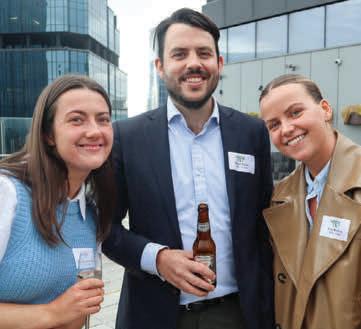
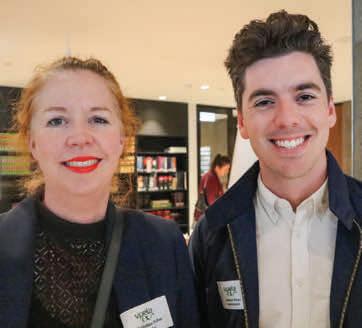
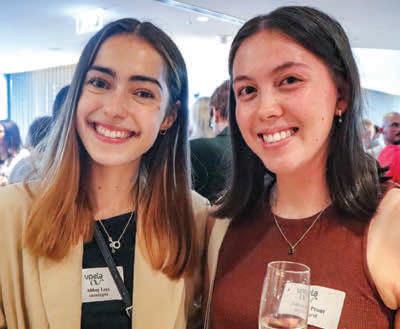
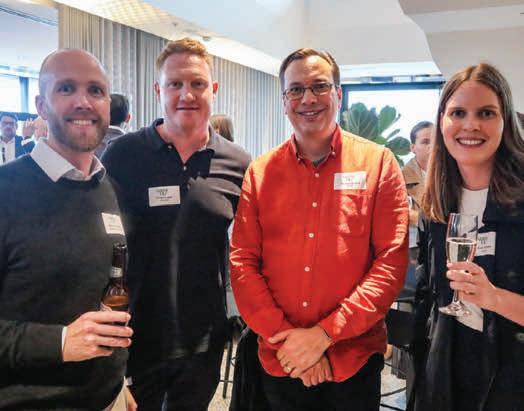
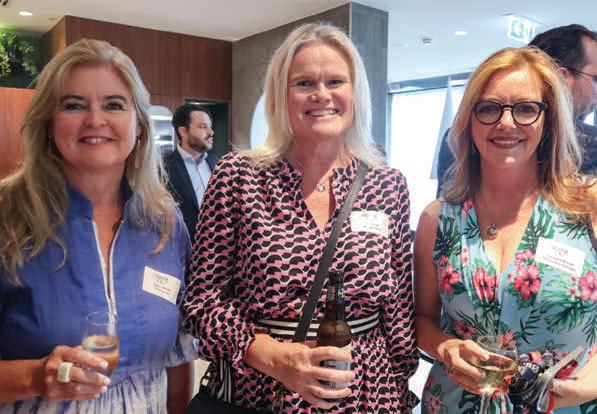
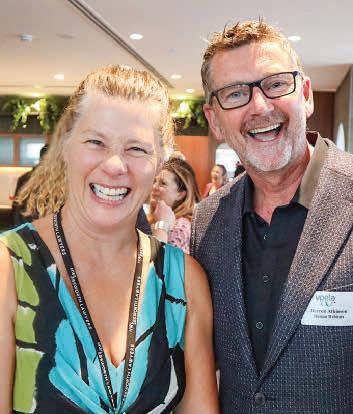
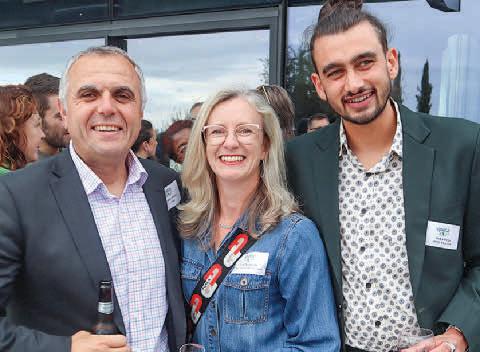

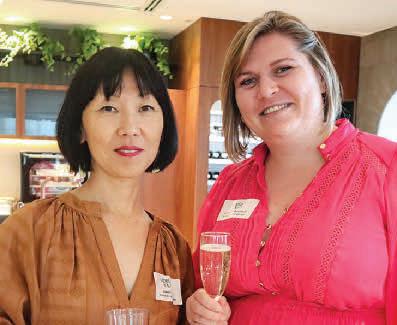

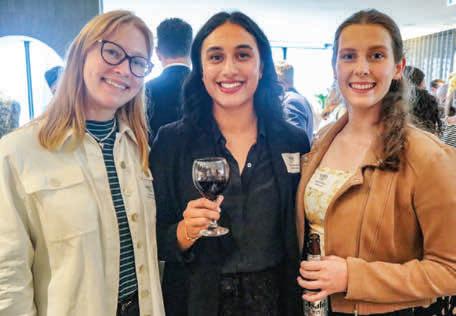
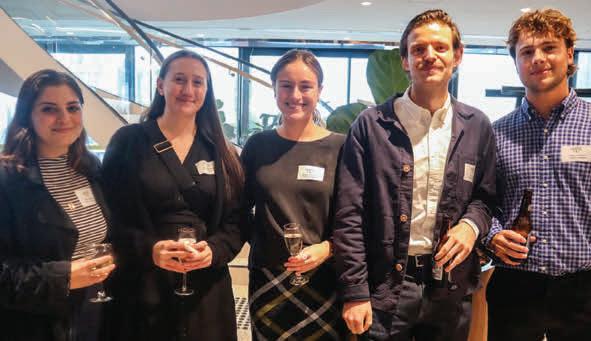
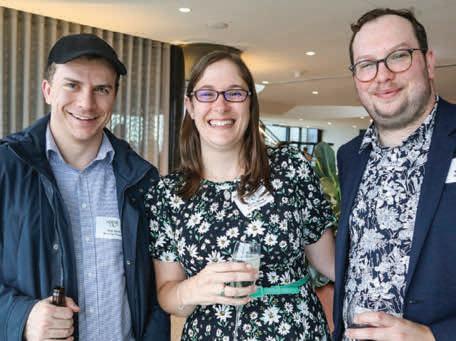
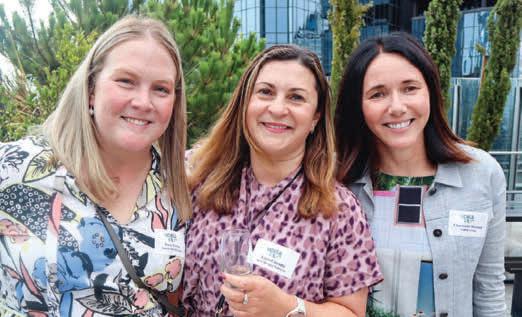
Hosted by Norton Rose Fulbright, the party was able to move to the impressive outdoor terrace enabling us to enjoy magnificent views of Melbourne after the storm cleared. Throughout the night, enthusiasm from the attendees was palpable and evident from the elevated volume of collective voices that rang through the event space!
On the whole, it was great to catch up with industry colleagues after a well-deserved summer break to contemplate an eventful 2022 and what promises to be an equally eventful 2023.
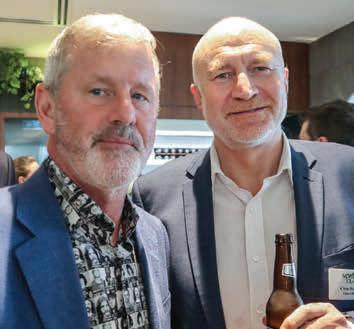
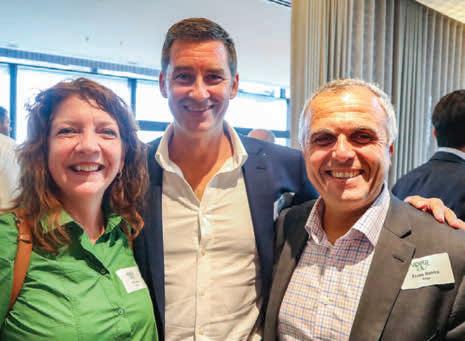
VPELA Revue March 2023 / 15 Summer
Drinks
15
Jack Chiodo is a Town Planner with Jackson Lane Legal
VPELA Christmas Party
In December, VPELA members gathered at Q Events on Queen Street to reflect on an amazing 2022 – a year that most agreed was busy and kept us all on our toes.
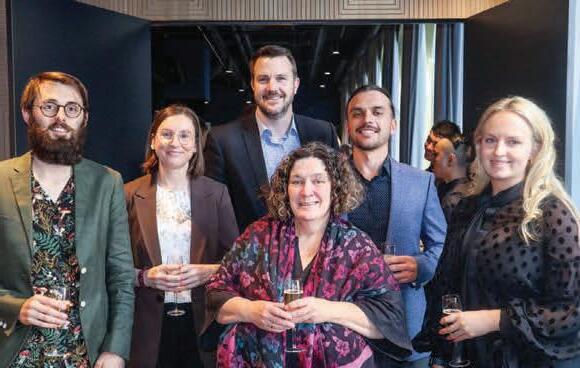


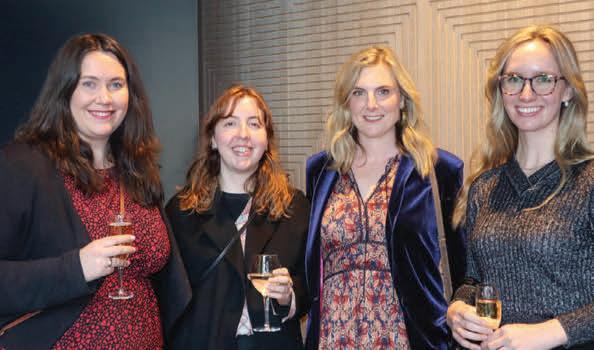


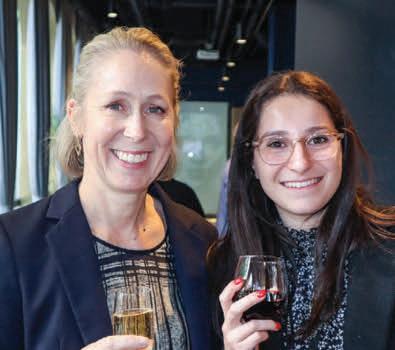
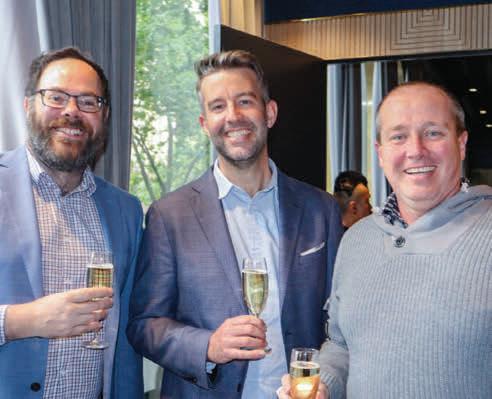
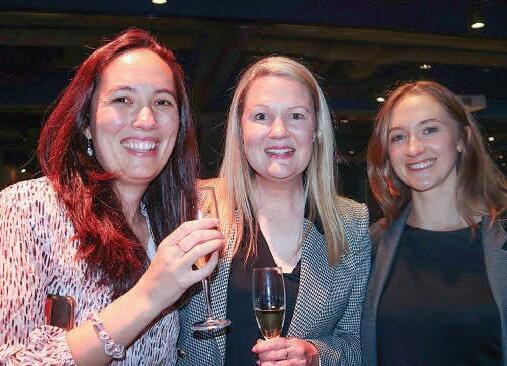
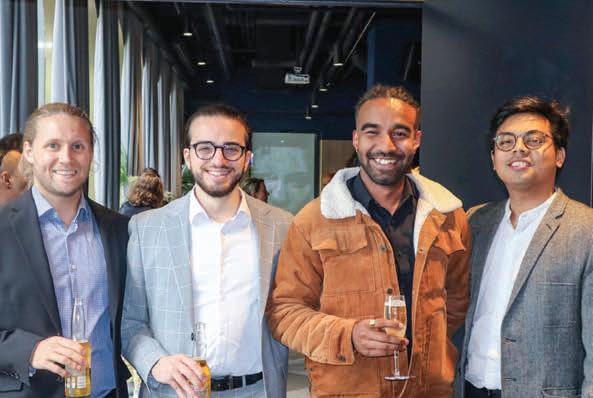
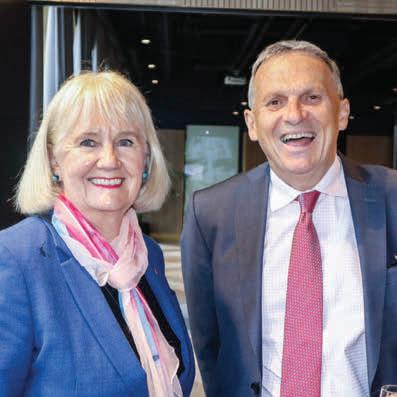
With VPELA putting on around 20 events in 2022, it was an incredible return to regular programming and a credit to the support staff, Board members, YPG Committee and Conference Committee.
After a concise but impactful welcome by onemilegrid Director, Valentine Gnanakone, we had the opportunity to thank outgoing Board members Tamara Brezzi, Cameron Alderson, Jonathan Halaliku and Liam Wilkinson, Revue editor Bernard McNamara, and YPG Co-Convenor Jack Chiodo for their respective contributions to the organisation. We were also able to raise a glass and reflect on the incredible contribution that the retiring Jane Power has made to VPELA. She’s been its heart and soul; not to mention its quietly humming engine room for more than two decades. onemilegrid was delighted to sponsor the event and offer the opportunity for friends and colleagues to bring a hectic year to a close.
We look forward to seeing you all in 2023. This year’s Christmas Party will be on us before we know it!
James Dear is an Associate at onemilegrid
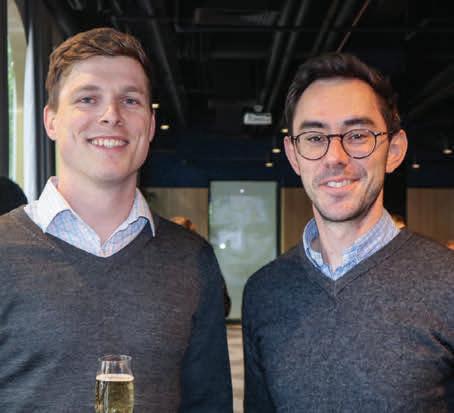
16 / VPELA Revue March 2023 Christmas
Party
16 VPELA Revue Newsletter -32pp A4 - Text-4 - Back - Outer - 28/03/2023 10:59:51 AM - K C M Y

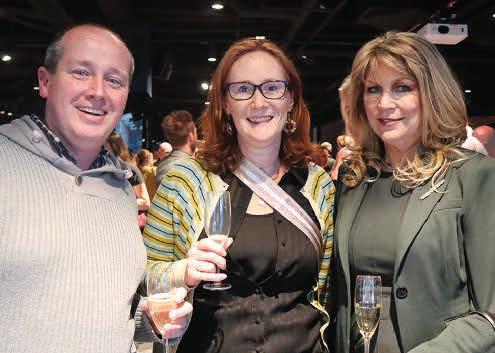
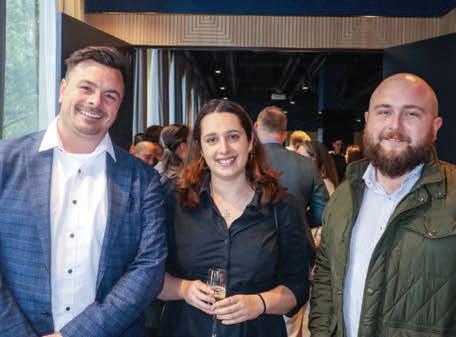
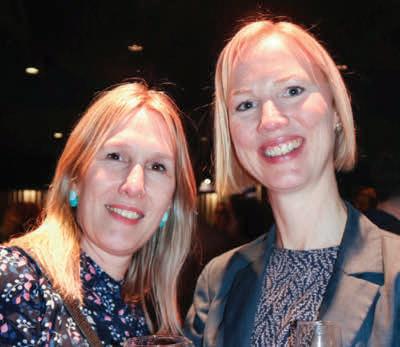

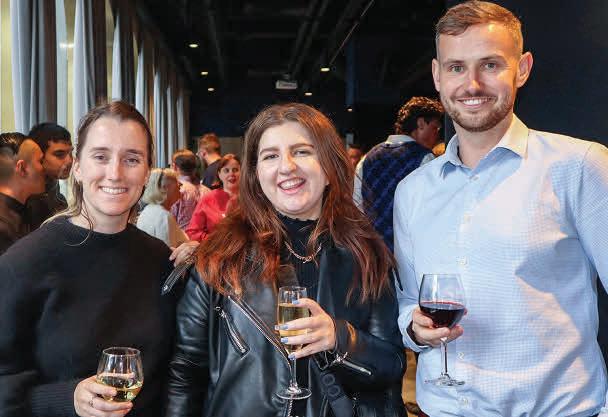
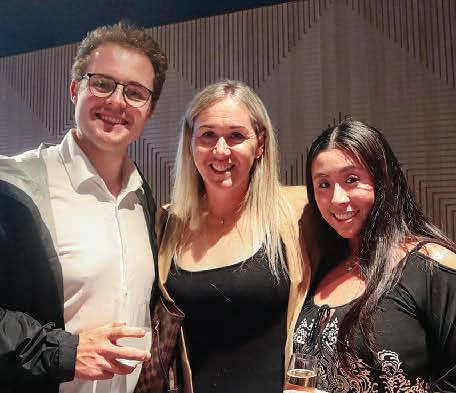
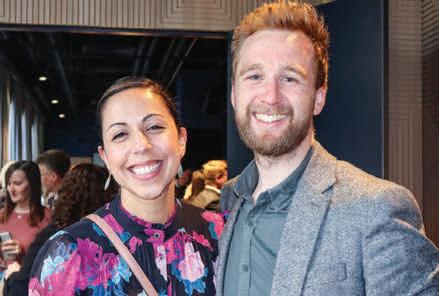
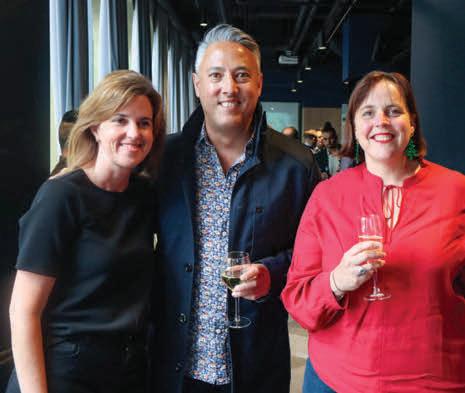
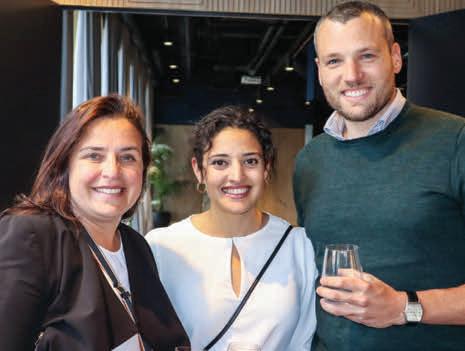
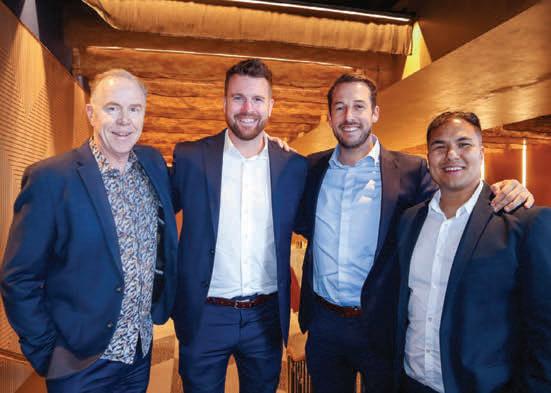
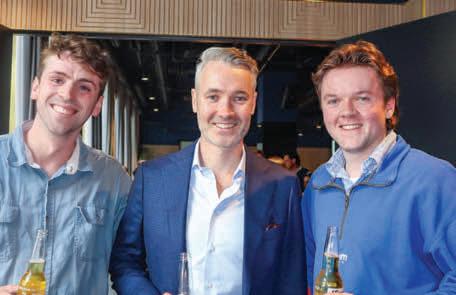


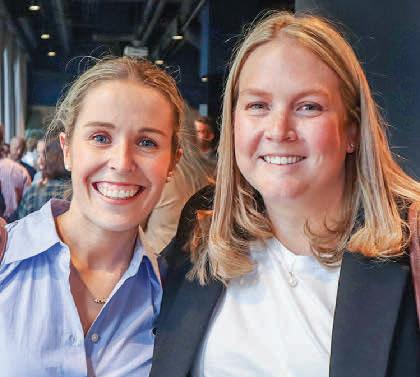
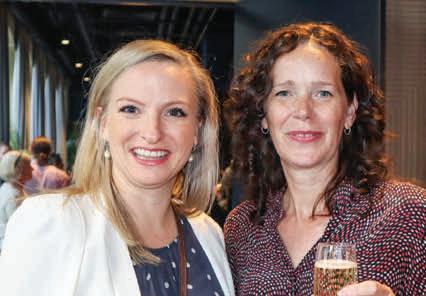
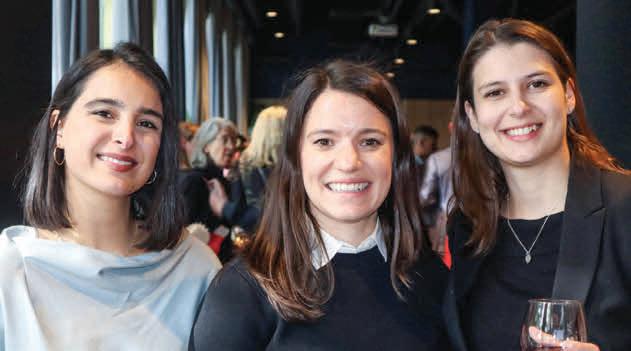

VPELA Revue March 2023 / 17 Christmas
17
Party
YPG Christmas Party
VPELA’s young professionals finished the year enjoying some well-earned time in the sun at the Fitzroy Bowls Club.
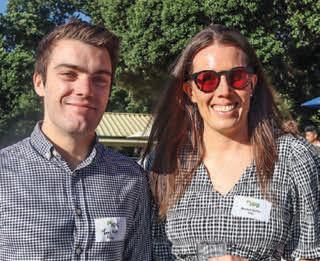
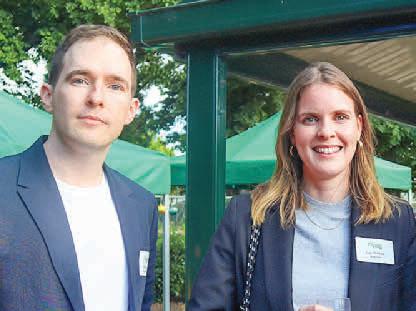
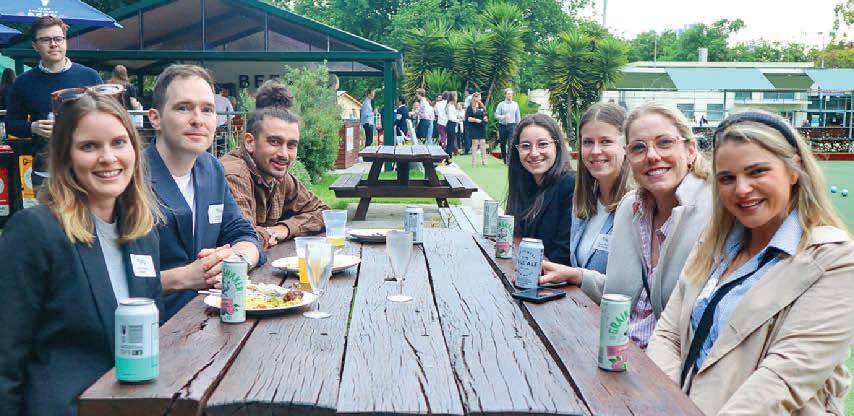
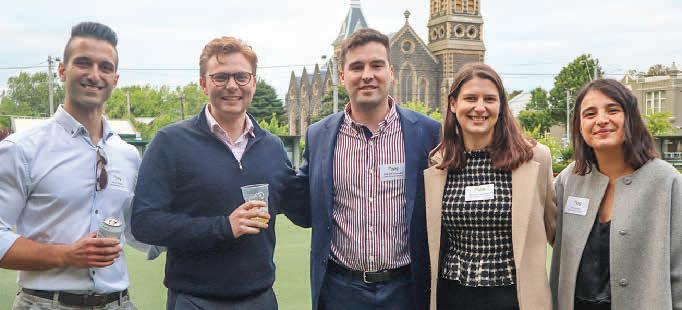
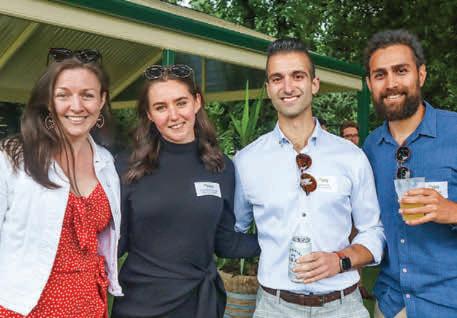
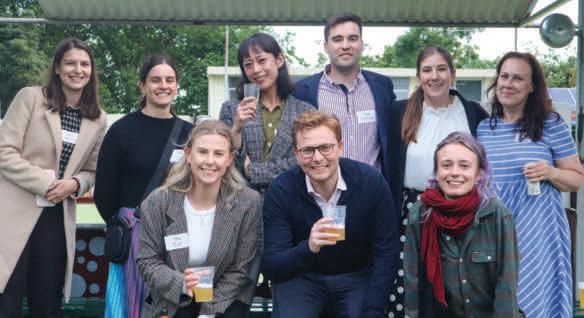



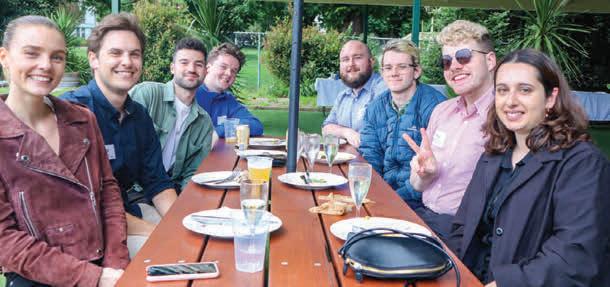

The Christmas Party turnout was outstanding - with a mix of young professionals competing for pride and glory on the bowling green. The traffic engineering contingent seemed to have an unfair advantage, taking out the competition with their superior understanding of patterns and movement. The event included some great food, drinks, and conversation, and was made all the better by some very pleasant weather. After bowls, the night continued at the Tramway Hotel with some more drinks and chatting across disciplines.
It was a great end to YPG’s 2022 calendar of events and we especially thank our sponsors Biosis, Taylors, Traffix Group and Urbis for their support. We now look forward to more events in 2023!
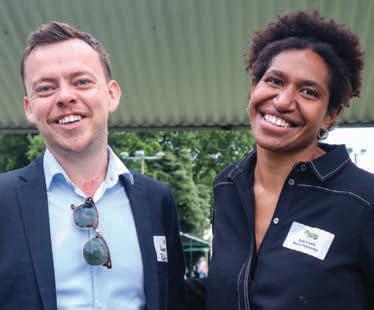

Dinan McMahon is a Graduate Planner at Cogency
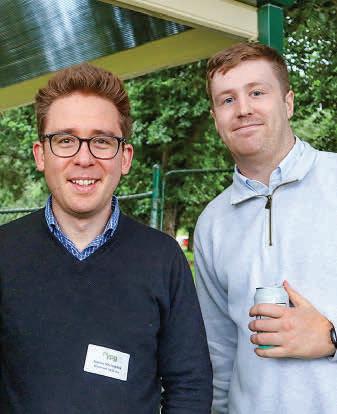
18 / VPELA Revue March 2023 YPG Christmas
Party
18 VPELA Revue Newsletter -32pp A4 - Text-4 - Front - Inner - 28/03/2023 10:59:49 AM - K C M Y
Places
Impacts of council decision making on community perception in growth area councils
The Local Government Act 2020 states that local government is an important level of administration with the purpose of ensuring ‘peace, order and good government’.1
Democratically elected councils have the functions and powers to make decisions in the interest of the community. Planning permit applications are a common agenda item at council meetings, requiring a decision in the interests of the community. Applications are often an area of interest for the community and influence the overall perception of a council’s performance when a decision is made on one.
Of the 79 councils throughout Victoria, there are seven recognised growth area councils in Victoria. Two growth area councils were dismissed and replaced by a panel of appointed administrators during the 2016 to 2020 council election period: Casey City Council (February 2020) and Whittlesea City Council (March 2020). The appointed administrators were to perform the role of council representatives until the 2024 council election. The dismissal of councils generally, but particularly in the growth areas within these two years, has influenced the overall perception of these councils’ performance when making decisions on planning permit applications and on the general local government sector.
A 2020 community satisfaction survey found local government planning to have, on average, low perceived performance scores across all councils in Victoria and identified planning as a service area requiring improvement to ensure negative community perceptions do not have an adverse impact on overall perceptions of council.2 Working to improve perceptions of planning through good communication and transparency with the community about procedures and decisions made at council meetings affords the greatest opportunity to improve overall opinion of planning and subsequently council performance.
This article focuses on the impact of planning permit application decision making on community perception. It presents explorative research undertaken to understand the number of planning permit applications decided at council meetings that have, or have not, been aligned with the recommendation of the assessing council officer and when council is making decisions in the interest of the community. This research reviewed decisions on planning permit applications (including amendments to planning permits but excluding strategic work) made by councillors at council meetings over four years during the 2016 to 2020 council election period. This research focussed on the three largest growth area councils by population: Casey City Council, Wyndham City Council and Hume City Council. The 612 council meeting agendas and minutes, including planning permit applications, were analysed for these three councils during the council election period from 22 October 2016 election day to 24 October 2020 election day. This article discusses the findings of this research through the following four questions of inquiry.
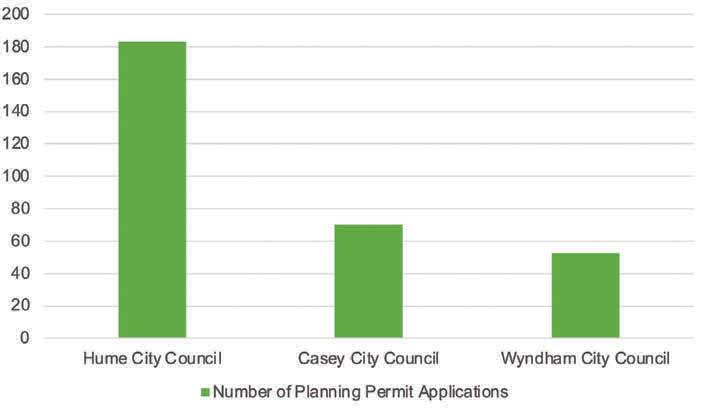
How many planning permit applications went to council meetings?
During the 2016 to 2020 council election period, Hume City Council had the highest number of planning permit applications going to
Sonja van Nieuwenhoven, recipient of 2021 VPELA Young Professional Award

to council meetings per council during the 2016 to 2020 council election period.
What were the most common officer recommendations?
A report on a planning permit application going to a council meeting will have an officer recommendation to either issue a permit or issue a Notice of Decision to Grant/Refuse to Grant a Permit 3 Not surprisingly, the most common officer recommendation is to issue a Notice of Decision to Grant a Permit as shown in Figure 2 below. These figures suggest most applications going to council meetings were the result of objections received to applications. A Notice of Decision to Grant a Permit is issued and ensures all objectors receive notice and the opportunity to lodge an application at VCAT for a review of the decision.4
The number of planning permit applications going to council meetings because of objections is influenced by the delegation council officers’ hold to make decisions on applications with objections. Council officers have different delegation across the three councils. The number of objections required for an application to go to a council meeting at Hume City Council is six, or more. Casey City Council had the same requirement prior to the administrators taking over in 2020; now it requires 20, or more, objections which has substantially reduced the number of applications going to council meetings. Wyndham City Council requires 15, or more, objections for an application to go to a council meeting, which is the highest number of objections required of three councils when averaged across the 2016 to 2020 council election period. This may suggest why it has the lowest number of applications decided at council meetings.
The second most common officer recommendation is to issue a Notice of Decision to Refuse to Grant a Permit. Again, this may be due to the number of objections received, council officer delegation, council policy on types of applications required to go to council meetings (such as those with particular permit triggers), or an application being ‘called-in’ by a councillor. Further officer recommendations include to
VPELA Revue March 2023 / 19
council meetings of the three councils, followed by Casey City Council, then Wyndham City Council, as shown in Figure 1 below.
Figure 1 – Number of planning permit applications going
19
issue permits or ‘other’ inclusive of deferrals and forming positions to advise VCAT, which all influence the community’s perception of a council’s performance.
Are councillors following officer recommendations?
Councillors are following officer recommendations on planning permit applications in the majority of cases. Hume and Wyndham City Councils have the highest percentage of officer recommendations being adopted at 87 percent, followed by Casey City Council at 77 percent.
Conversely, when decisions did not align with the officer recommendation, it was usually a decision to amend the officer recommendation from granting to refusing a permit. Casey City Council had the highest percentage of officer recommendation amendments to refuse a permit at eleven percent, closely followed by Wyndham City Council at eight percent and Hume City Council at four percent. The permit triggers were mostly for development of multi-dwellings comprising more than three dwellings on a lot.
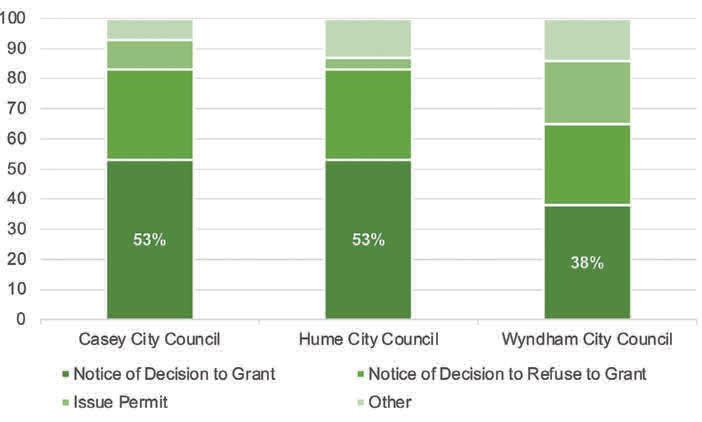
Further council decisions included amending the officer recommendation from refusing to granting a permit. While not evident in Wyndham
City Council, both Casey City Council at five percent and Hume City Council at two percent made these types of amendments. The permit triggers for these applications at Casey City Council were mostly for use and/or development of places of worship, and at Hume City Council for the creation or alteration of access, or to subdivide land adjacent, to a road in a Transport Zone. This research suggests active councillor involvement in influencing the outcome of locally contentious planning issues, and therefore also influences the community’s perception of council’s performance.
Other council decisions included deferring decisions to later council meetings, and forming positions to advise VCAT, with the strong majority being refusals across all three councils.
What were the most common permit triggers going to council meetings?
From change of use to development permit triggers, there are various types of planning permit applications going to council meetings. Out of the 84 permit triggers identified in this research, it is not surprising that multi-dwelling developments (categorised as more than three dwellings) is one of the most common permit triggers in applications going to council meetings across all three growth area councils as shown in Table 1 below.
Subdivision applications are either the first or second highest amount of planning permit applications received in growth area councils.5 What is surprising for growth area councils is that Casey and Hume City Councils have fewer subdivision applications going to council, particularly multi-lot subdivision (categorised as more than three lots) compared to Wyndham City Council. This could possibly be explained by Wyndham City Council having the fastest growing population of the three councils,6 the fact that it had more residential building approvals on average over the 2016 to 2020 election period,7 or that, as per its council policy, particular applications are required to go to council meetings, which are usually associated with contentious planning issues.
20 / VPELA Revue March 2023
Table 1 – Top three permit triggers in planning permit applications going to council meetings per council during the 2016 to 2020 council election period.
Figure 2 – Percentage of officer recommendations to issue a Notice of Decision to Grant a Permit per council during the 2016 to 2020 council election period.
Permit Trigger Rating Casey City Council Hume City Council Wyndham City Council 1st Development of Multi Dwellings (>3) and Vegetation and Tree Removal Development of Multi Dwellings (>3) Reduction or waiving of car parking requirements 2nd Development of 3 Dwellings and Creation or alteration of access or to subdivide land adjacent to a road in a Transport Zone Reduction or waiving of car parking requirements Development of Multi Dwellings (>3) 3rd Use or development of a Place of Worship Development of 3 Dwellings Multi Lot Subdivision (>3) and Use or development of a Child Care Centre 20
Local government planning is identified as an area for improvement regarding the community’s perception of councils and the overall local government sector. Despite the community’s perceived need for improvement, this research finds the majority of planning permit applications decided at council meetings are aligned with the recommendation of the assessing council officers at Casey, Hume, and Wyndham City Councils during the 2016 to 2020 council election period. Furthermore, this research suggests the small percentage of decisions not aligned with the officer recommendation may be influenced by locally contentious planning issues. Locally contentious planning issues can be associated with the type of application, its permit triggers, and subsequently the number of objections it recieves.
Although this research is not conclusive and requires further investigation, namely including other councils, it hopes to contribute to a better understanding of the relationship between council planning decisions and officer recommendations. This article is one step in the right direction to being more transparent on council decisions by directly and positively impacting perceptions of local government planning through the breakdown of information provided in the above four questions of inquiry. The findings are mostly positive and these councils are in a strong position to change community perception about local government planning decision and, subsequently, council performance.
I would like to thank Beveridge Williams for its continued sponsorship of the VPELA Young Professional Award and the support it provides young professionals, like me, to follow their interests and undertake research or study related to their profession. I encourage colleagues of young professionals to support their nominations for the upcoming 2023 VPELA Young Professional Award. For further information, go to the Young Professional Award page on VPELA’s website: https://www. vpela.org.au/about-vpela/awards/young-professional-award.
Sonja van Nieuwenhoven was the recipient of the 2021 VPELA Young Professional Award, which has assisted her to learn more about the impacts of council decision making on community perception in growth area councils. Sonja is a Principal Strategic Planner currently working at Casey City Council and can be contacted at snieuwenhoven@casey.vic.gov.au. Sonja undertook this research and article in her personal capacity. The suggestions expressed in this article are her own and do not necessarily represent the views of Casey City Council.
1 In this article, council is the responsible authority who assesses and decides on planning permit applications. When deciding to grant a permit, if there is no objection, council can issue a permit immediately, and if there is objection, council can only issue a Notice of Decision to Grant a Permit. When deciding to refuse to grant a permit, council issues a Notice of Refusal to Grant a Permit. Further information on the decision process can be found on the Department of Transport and Planning’s Permits and applications webpage, accessible at https://www.planning.vic.gov.au/ permits-and-applications/planning-permits/assessment-and-decision
2 VCAT stands for the Victorian Civil and Administrative Tribunal.
3 Sourced from Austlii, Local Government Act 2020, section 1, accessible at http://classic.austlii.edu.au/au/legis/vic/consol_act/lga2020182/s1.html
4 Sourced from the Department of Transport and Planning’s (previously Department of Environment, Land, Water and Planning) 2020 Local Government Community Satisfaction Survey, accessible at https://www.localgovernment.vic.gov.au/data/assets/pdf_ file/0024/168027/Local-Government-Community-SatisfactionSurvey-2020.pdf
5 Sourced from the Department of Transport and Planning’s Legacy Planning Permit Activity Annual Reports, accessible at https://www. planning.vic.gov.au/resource-library/planning-permit-activity-in-victoria/ reports/planning-permit-activity-annual-report-2021-22#Reports-tabs2
6 Sourced from the Australian Bureau of Statistics, data accessible at https://www.abs.gov.au/, and published on .id community for each council:
Casey City Council: https://profile.id.com.au/casey/population
Hume City Council: https://profile.id.com.au/hume/population
Wyndham City Council: https://profile.id.com.au/wyndham/population
7 Sourced from the Australian Bureau of Statistics, data accessible at https://www.abs.gov.au/, and published on .id community for each council:
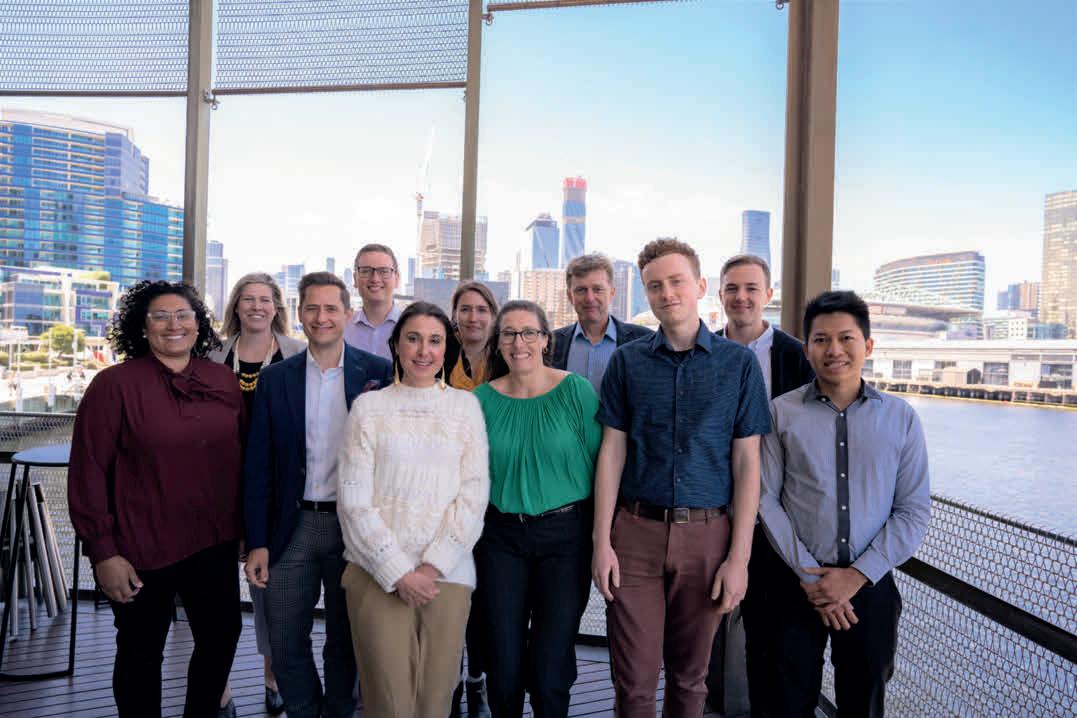
Casey City Council: https://profile.id.com.au/casey/building-approvals
Hume City Council: https://profile.id.com.au/hume/building-approvals
Wyndham City Council: https://profile.id.com.au/wyndham/buildingapprovals
Your ESD Consultants Energy | ESD | Daylight | WSUD Waste Management | JV3 | NatHERS ecoresults.com.au 21
Seminar
How well is the planning and environmental assessment process working for renewable energy projects in Victoria?
Introduction
Towards the end of last year, VPELA hosted a seminar as part of its Net Zero Series which asked the speakers: how well is the planning and environmental impact assessment process working for renewable energy projects in Victoria?
The panel of speakers, which comprised Michael Juttner (Manager Renewables, DELWP),1 Geoff Ralphs (Director Impact Assessment, DELWP), Katie Watt (Senior Principal Environmental Consultant, Tetra Tech) and Emily Porter SC (Barrister, Victorian Bar), engaged in a lively discussion questioning how and where the regulatory systems can do better, particularly in light of the Victorian Government’s recent announcements.
Setting the policy scene
The renewable energy transition in practice
On the same day as the seminar, AGL held its Annual General Meeting and resolved to target a 2035 closure date for the coal-fired Loy Yang A Power Station, which generates approximately 30% of Victoria’s power requirements, bringing the target closure date forward by 10 years.
Coupled with EnergyAustralia’s 2028 closure of the Yallourn Power Station, which generates approximately 22% of Victoria’s power requirements, the renewable energy transition in Victoria is no longer just a policy aspiration.
New renewable energy generation and storage targets, and emissions targets
The seminar was timely as the Victorian Government, in the lead-up to the State election, had recently announced new:
(a) renewable energy targets – increasing to 65% by 2030 (was previously 50%) and to 95% by 2035;
(b) renewable energy storage targets – 2.6 GW of renewable energy storage capacity by 2030 and 6.3 GW by 2035 to bolster energy reliability; and
(c) emissions reduction targets of 75-80% by 2035 and net zero emissions by 2045 – the most ambitious from any mainland state.
Now re-elected, we anticipate that the new renewable energy generation and storage targets will be soon legislated through the Renewable Energy (Jobs and Investment) Act 2017 and the emissions reduction targets through the Climate Change Act 2017
Offshore wind targets
In October 2022, the Victorian Government released Offshore Wind Implementation Statement 1, outlining plans for the establishment of an offshore wind industry with the target of bringing online at least 2 GW of capacity by 2032, 4 GW by 2035 and 9 GW by 2040.
Jamie Truong, Lawyer, Hall & Wilcox

In December 2022, the Federal Minister for Climate Change and Energy declared an area in the Bass Strait off Gippsland as being suitable for offshore renewable energy,2 and invited proponents to apply for feasibility licences within the declared area (applications close on 27 April 2023).3
Reviving the State Electricity Commission
A further pledge was made to establish a publicly owned corporation (the State Electricity Commission) that would see the State hold a controlling stake in new renewable energy projects, as well as build new renewable energy projects.
Through an initial investment of $1 billion from the Victorian Government, the State Electricity Commission will be tasked with delivering 4.5 GW of power through renewable energy projects – the equivalent replacement capacity of Loy Yang Power Station.
The assessment and approvals task is unprecedented
The Australian Energy Market Operator predicts that a further 37.5 GW of additional wind (onshore and offshore), solar and storage projects are in the pipeline (see Figure 1).
The volume and scale of new renewable energy projects will be keeping VPELA members busy for many years to come. Hence we ask: how well is the planning and environmental impact assessment process working for renewable energy projects in Victoria?
The Western Australian Government has taken a proactive approach, announcing that it would establish ‘a new dedicated cross-government Green Energy Assessment Unit’ which will ‘develop clear assessment pathways and provide high-quality, fit-for-purpose, timely support for proponents and investors’ and ‘implement novel assessment processes for green energy projects, to facilitate smoother and faster project approvals’.4 The Green Energy Assessment Unit is expected to be operational by mid-2023.
The regulator’s perspective – fine-tuning the existing assessment and approvals process
From 2 April 2015, after Amendment VC124, the Minister for Planning became the responsible authority for all new planning permit applications for the use and development of land for the purpose of a Wind energy facility
On 17 September 2019, after Amendment VC161, the Minister for Planning’s role as responsible authority was further expanded from ‘Wind energy facilities’ to ‘Renewable energy facilities with an installed capacity of 1 megawatt or greater’.
As a result of those changes, Michael’s team has been playing a key role in assessing and approving renewable energy projects. For example, in 2022, 48 approvals were issued ranging from new permits, amended permits and incorporated documents via section 20(4)
22 / VPELA Revue March 2023
22
amendments with a development value of $2.83 billion, generating or storing 2,882 MW of energy.
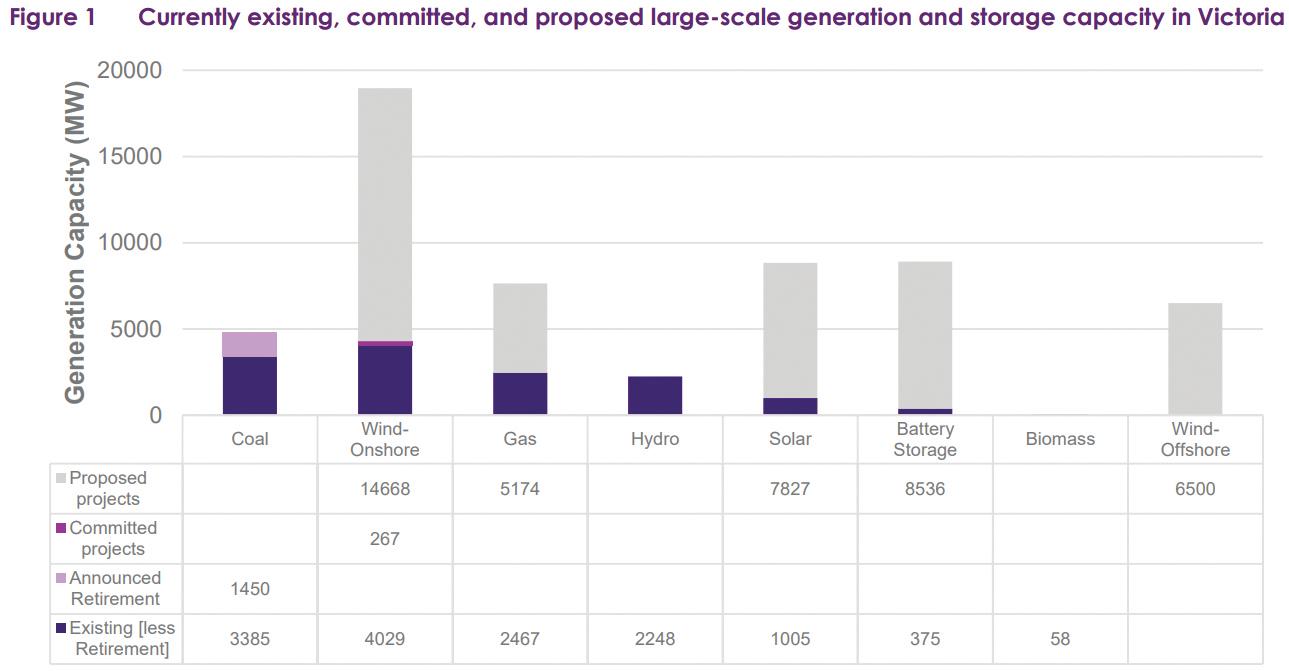
For renewable projects that can cause more environmental impacts, the Minister for Planning can require the preparation of an Environment Effects Statement under the Environmental Effects Act 1978. Over the last 4 years, Geoff’s team has seen an uptick in renewable energy projects commence or go through the Environment Effects Statement process, including the Star of the South Offshore Wind Farm, Portland Offshore Wind Farm, Seadragon Offshore Wind Farm and the Hexham Wind Farm.
As confirmed by Michael and Geoff, the assessment and approvals task is only getting bigger.
Some key lessons for current and future renewable energy project proponents were:
being aware that the planning scheme discourages solar farms in declared irrigation districts;
engaging expert planning advisors to navigate the system;
engaging early on with Traditional Owners;
preparing concise and accessible supporting reports;
having reasonable timeframe expectations for a decision, and understanding third-party appeal rights in Victoria; and
reviewing permit conditions carefully and engaging appropriate expertise to fulfil permit conditions.
The assessment and approvals process will undoubtedly be smoother if proponents take heed of the above lessons, even without implementing fundamental structural changes to the assessment and approvals process.
The consultant’s perspective –understanding the challenges and seizing the opportunities
Katie opened her comments by noting the ever-increasing complexity in approvals pathways, including the new regulatory framework for offshore wind projects, which many consultants have been grappling with in recent times.
Being the consultant that guides projects through the assessment and approvals process, Katie noted some key approvals challenges:
The balancing exercise between providing design certainty for the community/stakeholders versus facilitating flexibility in project delivery and encouraging design innovation from contractors.
The ever-increasing detail and complexity in Environment Effects Statements, especially for offshore wind projects.
The assessment of project options through the Environment Effects Statement process.
The disconnect between approval triggers and community/ stakeholder expectations.
Katie challenged those in the room to find solutions and seize the opportunities to improve the assessment and approvals process. For example, how can the assessment and approvals process better align, or provide more synergy, with proponent procurement/tendering processes.
VPELA Revue March 2023 / 23
Figure 1 –
23
Source: Victorian Annual Planning Report prepared by the Australian Energy Market Operator, dated October 2022
The lawyer’s perspective – managing legal risks during scoping and project assessment phases
As noted earlier by Michael and Geoff, and confirmed by Emily, renewable energy projects, particularly onshore wind farms, are increasingly subject to litigation in the Tribunal and in the Courts.
Emily encouraged project proponents to manage their legal risks throughout the project lifecycle, from project scoping through to the assessment and approvals process. In some cases, a failure to manage legal risk can result in unfavourable decisions (refusal or unfavourable conditions) or third-party review.
Project scoping lessons included better defining the project’s impact envelope, taking a cautious approach when using the ‘reference design’ method and seeking appropriate advice when endeavouring to change the project scope (either during or after the assessment and approvals process).
In terms of managing legal risk during the assessment and approvals phase, it was noted that judicial review proceedings in the Supreme Court have become much more commonplace, particularly for wind farm projects. This has placed additional scrutiny on how community consultation is conducted and how decision makers consider and give weight to expert evidence.
With recent decisions in 2022 such as The People of the Small Town of Hawkesdale Inc v Minister for Planning [2022] VSCA 167 (standing and power to extend permits) and Uren v Bald Hills Wind Farm Pty Ltd [2022] VSC 145 (nuisance and noise compliance), project proponents should, as Emily encouraged, manage legal risks during the project lifecycle and seek appropriate expert advice along the way.
Where to now?
With the unprecedented amount of renewable energy projects being initiated by proponents, will Victoria’s planning and environmental assessment process stand up to the test? Have we improved the system since the 2010 Parliamentary inquiry into the approvals process for renewable energy projects in Victoria or the 2011 Parliamentary inquiry into the Environment Effects Statement process in Victoria?
Regardless, step one for us in the industry is to understand the lessons learnt from the panel of speakers, and incrementally improve on how we assess and approve renewable energy projects.
Jamie Truong is a Lawyer with Hall & Wilcox
1 Now Department of Transport and Planning.
2 Offshore Electricity Infrastructure (Declared Area OEI-01-2022) Declaration 2022.
3 Offshore Electricity Infrastructure (Invitation to Apply for a Feasibility Licence) Instrument (No. 1) 2022.
4 Media release of the Western Australian Government, dated 6 December 2022 (https://www.mediastatements.wa.gov.au/Pages/ McGowan/2022/12/New-approach-to-fast-track-green-energy-approvals. aspx)
Welcome to our new members…

Michelle Blackburn Corrs Chambers Westgarth
Carmen Bradfield Norton Rose Fulbright
Alan Brennan Nature Advisory
Nicky Casey UPco – Urban Planning Collective
Dani Davidovits MinterEllison
Karen D’Mello Beveridge Williams
Jessica Denison Urbis
Maeve Dowty Arcadis
Thomas Duffy Russell Kennedy
Tasma Eddy Frankston City Council
Shi-Mei Ewing
Claire Findlay County Court
Claud Gallois Hansen Partnership
Bridget Goodear Beveridge Williams
Adam Greenberger Suburban Rail Loop Authority
Erin Hautea AURECON
Josh Kennedy UPco – Urban Planning Collective
Jessica Leane Hobsons Bay City Council
Abbey Leys onemilegrid
Arthur Lim proUrban
Karmen Markis Russell Kennedy
Brigette McKay UPco – Urban Planning Collective
Joshua McLennan Biosis
Adam Mitchell Major Transport Infrastructure Authority
Esten Narum Marshall Day Acoustics
Catherine Neidhardt Norton Rose Fulbright
Vu Nguyen Orbit Solutions
Rebecca O’Brien
Kylie Patrick Avisure
Stewart Plant Jamaica Prout onemilegrid
Anna Raftery Suburban Rail Loop Authority
Alex Rossen
Victoria Tangey
Matt Taylor Russell Kennedy
George Vasilopoulos Nillumbik Shire Council
Nicole Vickridge Greenwood Consulting
Victoria Vilagosh PwC
Olivia Walkinshaw Urbis
Ravi Walsh AURECON
Christopher Watt Holding Redlich
Michael Wheelahan Proud Mary Consulting
24 / VPELA Revue March 2023
24
The Business Net Community Benefit, and Retirement and Aged Care facilities
Planning and responsible authorities should endeavour to integrate the range of planning policies relevant to the issues to be determined, and balance conflicting objectives in favour of net community benefit and sustainable development for the benefit of present and future generations.
– Clause 71.02-3 – Integrated Decision Making – Victorian Planning Policy Framework
Planning in Victoria should facilitate outcomes that create a positive net community benefit. Decision makers must consider how a proposal achieves this objective. Proposals will have benefits and disbenefits for the community, and the decision maker must consider which way the scales tip and make a determination accordingly.
Net community benefit is an inherently subjective and nebulous aspect of a decision maker’s purview. As the Victorian Civil and Administrative Tribunal (Tribunal) has put it:
The balancing task involves judgment and not a mathematical or ‘tick a box’ approach.1
A recent example of a development application concerning a proposal for a retirement village and residential aged care facility (RACF) on the Mornington Peninsula provides an illustrative example of how a proposal can tip the scales in favour of net community benefit. It also illustrates how the question of need may be relevant in such an assessment.
Ryman Healthcare – Mt Eliza (V1)
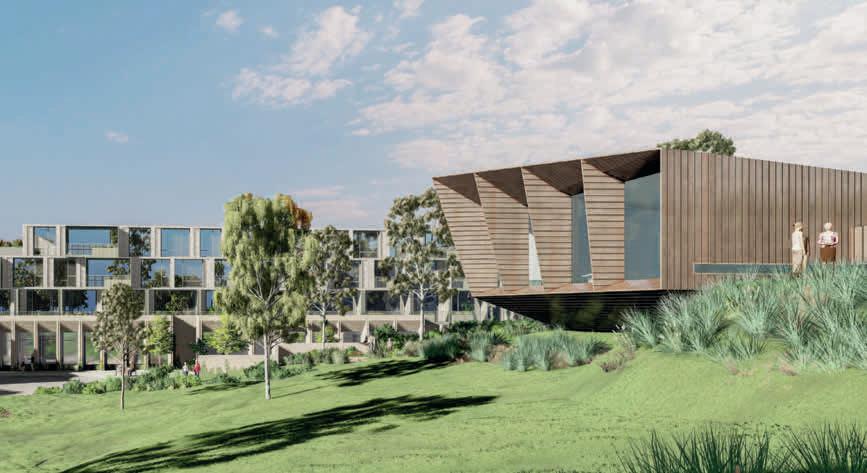
In Ryman Healthcare (Australia) Pty Ltd v Mornington Peninsula SC 2 (Ryman #1), the Tribunal considered a proposal for a retirement village and RACF on a large bayside site in Mount Eliza. The site sits on the coast, within the Urban Growth Boundary (UGB) and is occupied by a heritage mansion, called Moondah, and other associated buildings which some readers might know as the former Mount Eliza Business School. The buildings and land have been vacant and unused for some time.
Amanda Johns, Director, Planning & Property Partners
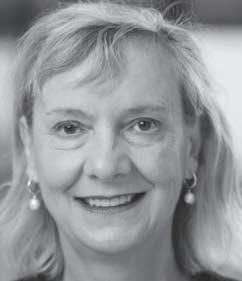 Tom Morrison, Lawyer, Planning & Property Partners
Tom Morrison, Lawyer, Planning & Property Partners

The Tribunal found, in considering the proposal, that its benefits included:
The restoration and adaptive reuse of the Moondah Mansion, with consequential improvements to the condition of the key heritage fabric.
Activation of a vacant site and foreshore access for future users of the land.
Introduction of an integrated stormwater management system and enhancement of coastal vegetation, thereby reducing coastal erosion.
Provision of high-quality aged care that meets the needs of Mount Eliza and the broader Mornington Peninsula community.
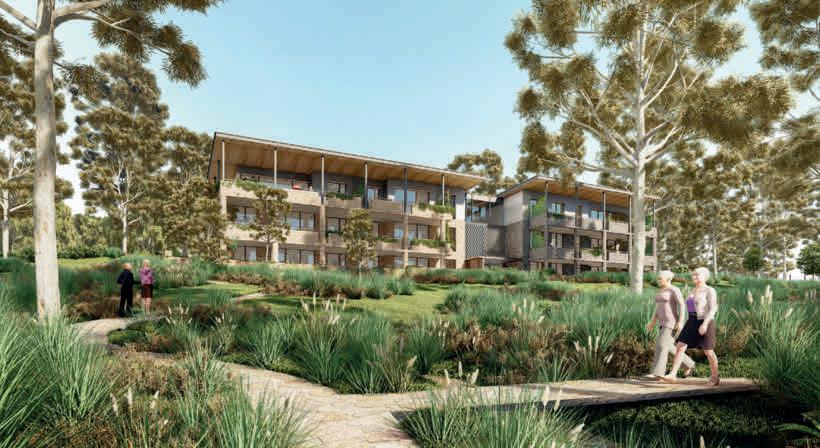
However, in the balancing act, the potential disbenefits of the proposal as considered by the Tribunal were:
The site was considered to be outside an existing settlement area, making an urban use undesirable; and
The proposed scale of building and development would not be consistent with the character expected of this site.
The Tribunal considered the issue of need for such facilities, being a relevant factor in the balancing of competing policy objectives. It found that there was no evidence that localised need for such facilities could not be met if the permit were refused. It found that the claimed need did not outweigh the deficiencies in responding to other relevant planning policies.
The Tribunal considered the competing issues and found:
…when evaluating the proposal in light of net community benefit and sustainable development, we consider priority needs to be given to preserving what is unique about this site. This would require a more consolidated and considered building layout or scale…3
Accordingly, no planning permit was issued for the proposal.
VPELA Revue March 2023 / 25
Level 5, 18 Oliver Lane ABN 68 065 207 490 Nominatied Architects Owen Chow 14643 Tristan Wong 18127 SJB Architecture Pty Ltd E info@sjb.com.au W sjb.com.au A PLACE OF WORSHIP EXTERNAL PERSPECTIVE Drawing no. Project no. Project address 60-70 Kunyung Rd, Mt Eliza Revision no. Project name. Client Ryman Mt ElizaRyman Healthcare Level 5, 18 Oliver Lane Melbourne VIC 3000 Nominatied Architects Michael Bialek 12804 Tristan Wong 18127 SJB Architecture Pty Ltd T 61 9699 6688 W sjb.com.au A WESTERN PERSPECTIVE OF BUILDING A Drawing no. Project no. Project address DA15 21605 60-70 Kunyung Rd, Mt Eliza Revision no. Project name. Client Ryman Mt ElizaRyman Healthcare 25
Ryman Healthcare – Mt Eliza (V2)
Eighteen months later, in Ryman Healthcare (Australia) Pty Ltd v Mornington Peninsula SC (Ryman #2), a new proposal for a retirement village and RACF on the site was considered by the Tribunal.4 In such a short time, the broader circumstances surrounding the proposal had not changed in any meaningful way.
The proposal put to the Tribunal in Ryman #2 was guided by the findings of the Tribunal in Ryman #1. The proposed built form was reduced to provide an improved response to the existing character of the site and its surrounds, seeking to preserve what makes it unique.
The benefits of the proposal remained much the same as in Ryman #1: activation of a vacant site in a special location, preservation and improvement of heritage fabric and the provision of high-quality aged care to meet community need.5 Consideration of the question of need differed from the previous decision.
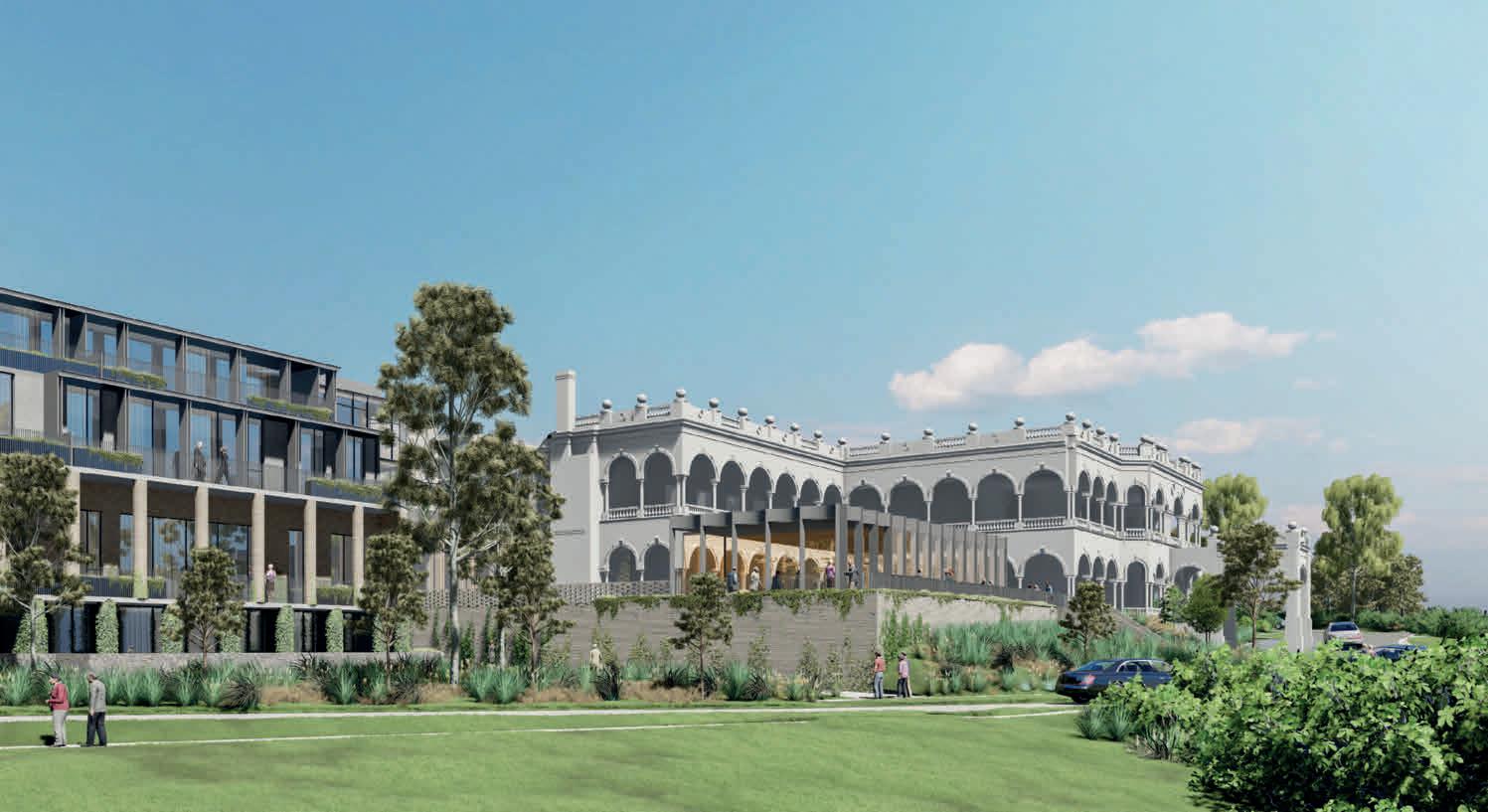
On the question of need, the applicant put to the Tribunal that the proposal’s benefits ought to be given greater weight because of the need for aged care facilities on the Mornington Peninsula (not just Mount Eliza), adducing evidence of an expert in aged care. Specifically, evidence was led regarding a need for aged care facilities which provide for a continuum of care as part of one facility (ie. the ability to move to higher care facilities on the same site when required). In its findings, the Tribunal gave weight to the continuum of care model and accepted that there will be an increased demand for a range of housing options in the municipality. It found that a quantitative assessment should be factored into an assessment of future demand that needs to be considered when determining the weight given to the range of applicable planning policies.
In conclusion, by reducing the built form and tailoring the proposal’s site response, the Tribunal found that the applicant had: …responded to the shortcomings of the previous scheme outlined by the Tribunal in the previous decision such that the scales have swung in favour of the proposal providing a net benefit to the community and for the benefit of future, particularly the elderly, generations.6
On this basis, the Tribunal directed the grant of a permit. It appears that the question of need involving a qualitative assessment of supply and demand and the type of facilities proposed played a significant positive factor in the decision-making process of the Tribunal. In this case, need was a positive factor taken into consideration in balancing the net community benefit (the overall benefits and disbenefits) of the proposal. It appears from this decision that evidence to support an argument that need is a positive benefit in assessing net community benefit should be considered in case strategy preparation where this issue is relevant and of importance. In the aged care context, not only will a qualitative assessment be needed, but a quantitative assessment should be undertaken in relation to supply and demand for such facilities in the relevant area (which may be broader than the local neighbourhood).
Amanda Johns and Tom Morrison are part of the legal team at Planning & Property Partners
1 Ryman Healthcare (Australia) Pty Ltd v Mornington Peninsula SC [2022] VCAT 1495 at [433].
2 [2021] VCAT 711.
3 Ryman Healthcare (Australia) Pty Ltd v Mornington Peninsula SC [2021] VCAT 711 at [464].
4 [2022] VCAT 1495.
5 For further discussion of need in planning appeals, see Shell Company of Australia Ltd v City of Frankston (1983) 8 APA 126.
26 / VPELA Revue March 2023
Level 5, 18 Oliver Lane Melbourne VIC 3000 ABN 68 065 207 490 ACN 065 207 490 Nominatied Architects Michael Bialek 12804 Owen Chow 14643 Tristan Wong 18127 SJB Architecture Pty Ltd T 61 3 9699 6688 E info@sjb.com.au W sjb.com.au A WESTERN PERSPECTIVE OF BUILDING C Drawing no. Project no. Project address DA25E 21605 60-70 Kunyung Rd, Mt Eliza Revision no. Project name. Client Ryman Mt ElizaRyman Healthcare
Don’t forget to check out VPELA’s facebook page. This is a great way to keep in touch with what’s on.
26
You can find us at VPELA 1
The Business An Architect’s perspective
Often I talk about the need to ‘see in 3D’ being a quintessential skill for architects. Prior to the advent of 3D computing, it is how great architects considered and designed spaces. It is also the skill that separates many architects and interior designers from other of our industry peers. There is no ‘3D Vision 101’ taught at universities. Rather, ‘seeing in 3D’ is a skill acquired after hours of vigorous architectural training, and painstakingly honed through real-world practice that trains the brain to master spatial awareness and understanding of spatial flow, circulation, and other design elements.

The Better Apartment Design Standards (BADS) were introduced in 2018 and envisaged as a tool to combat poorly designed apartments in Victoria. Since their inception, there is no doubt the initiative has brought about a vast improvement to the quality of accommodation in contemporary apartment buildings. No one argues that this is not a very good thing. What’s more, the standards are also contributing to a shift in how we envision living in the future. Better designed apartments and more sustainable buildings have the propensity to make apartment living not just a viable alternative to the white picket fence and quarter acre block, but the preferred alternative. Again, this is a good thing. The design purist in me will always champion less red tape, but I do not deny BADS the kudos due.
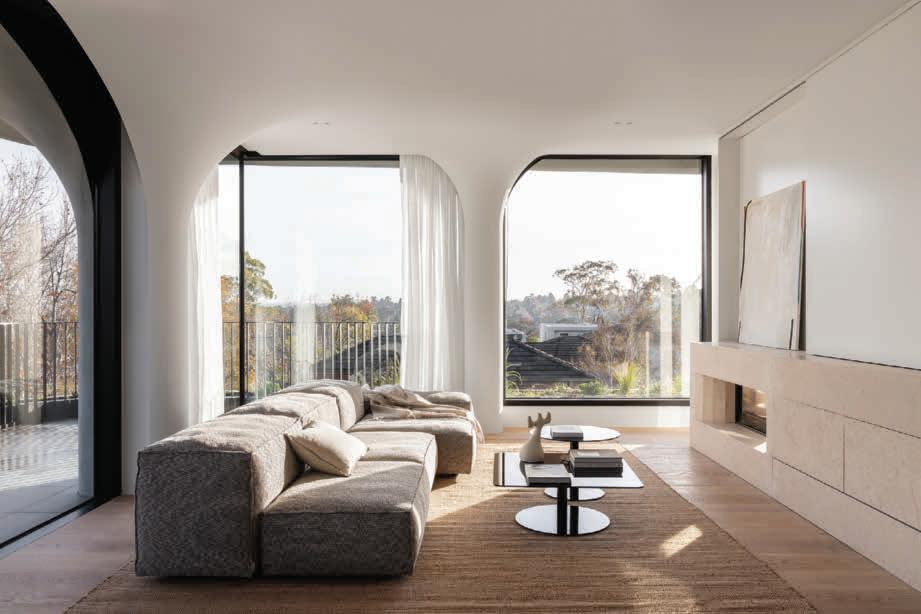
That said, I cannot shake the feeling that while BADS has lifted the lowest common denominator, it has simultaneously clipped the wings of architects who strive to deliver more creative and innovative multiresidential design responses. One of my early concerns with BADS was that we would start to lose design freedom and risk homogeneous outcomes; however, the ability to vary the standards does pave the way for design that can be innovative, unique and individual.
Whilst the standards in many cases are quite prescriptive, they are sensibly discretionary and intended to focus users on meeting design objectives. Frustratingly for architects, many assessing applications are still very focussed on compliance, especially in relation to quantitative standards, and less on questioning whether design objectives are met. Many are still not considering how a dwelling that does not meet a standard can still function for its occupants day to day. Does the design meet the qualitative objectives of BADS, regardless, noting that the nominated standards are just one way of meeting the design objective/s?
In theory, there are mechanisms in place to avoid BADS resulting in ‘clipped wings syndrome’; however, in reality, it is my view that these mechanisms are often overlooked. Responsible authorities find it easier to urge compliance with quantitative standards than consider functionality of the apartment more closely against design objectives. From my observations and experience, even the slightest hint of variation can easily become the lever to condition changes to plans, often for change’s sake or, worse, refuse applications. This is a
real shame as, ironically, variations to a standard can often result in better quality living environments.
At the Victorian Civil and Administrative Tribunal (VCAT), my sense is the picture is a little different. A review of decisions relating to projects designed in my office reveals a willingness to consider and, in many cases, accept design variations based around the Tribunal’s satisfaction that objectives have been met. The ‘keeping an open mind’ approach and reminders about the discretionary nature of standards are very important if the community wants to encourage architects and their clients to innovate and inspire with their work. However, from where I’m sitting, there are some serious flaws to this process that need to be reconsidered.
Recently, Cera Stribley was involved in VCAT cases where, somewhat perplexingly, it was not the design architect demonstrating the apartment’s ‘functionality’; rather, an expert that is almost always a town planner. I find this incredibly frustrating and concerning for architects. How, and why, has our industry cultivated an environment in which other professionals are being asked to assess the functionality of internal spaces, when they would seemingly be less qualified to do so?
As a practice owner and an architect with over 17 years’ experience navigating the Victorian planning system, I have the utmost respect for planners and urban designers, and the significant role they play in the considered curation of our urban fabric. The work that they do in reviewing and critiquing the external architecture of proposed buildings in relation to the surrounding built environment helps to keep architects, as designers, accountable and our solutions wellconsidered; ultimately contributing constructively to the ongoing development of our cities.
My qualm is not with planners themselves. Nor is my argument against the crucial role that they play in providing guidance on aspects such as accessibility, liveability, sustainability and safety in the context of
VPELA Revue March 2023 / 27
27
Domenic Cerantonio, Managing Principal, Cera Stribley Architects
multi-residential design. My frustration is with the Planning Scheme, and with the architects’ bodies that seemingly allow it to continually dilute our profession.
In our industries, we can all read a plan, assess a plan, and have an opinion on the layout of a dwelling, professionally, or not. However, I respectfully argue that, in many instances, architects are best placed to determine whether a proposed variation to a standard or standards can be approved. As it stands, the assessment of ‘functional internal layouts’ is being reduced to rely so heavily on quantitative measures, that opportunities for more qualitative outcomes are all too often being overlooked because those reviewing them lack the capacity to envision a plan multi-dimensionally. Not only is this risky in the sense that it is limiting the propensity for design and innovation, but by diluting the assessment of apartment layouts so purely to quantitative measures, we strengthen the case for AI (artificial intelligence) to render the whole process obsolete.
I know I am not alone with my frustration, having had countless conversations with fellow architects who similarly feel that their work is being thwarted throughout this process. Likewise, I have aired these thoughts with my friends and peers in planning and heard what they have to say. Naturally, the majority have argued the importance of having proposals assessed by an independent party –a proposition that I do not disagree with per se – and raised concerns about what it would mean to remove planners from this aspect of the assessment process.
To be clear, I am not suggesting there should be no provision for the review of functionality of apartments within the Planning Scheme. That would almost certainly lead to some terrible design outcomes and no architect ‘worth their salt’ would want those. I am suggesting,
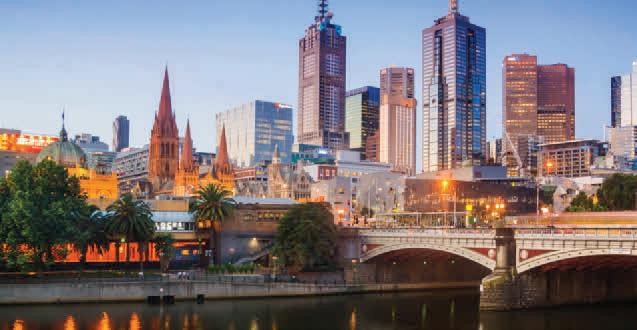
however, that there is a case to be made for architects to assess the merit of these variations.
While architects, planners and urban designers all have a critical role to play in ensuring that new apartment buildings meet the standards for design, functionality, and safety, it is an architect’s perspective –that innate ability to ‘see in 3D’– that is needed to duly assess what is, or is not, a ‘functional internal layout’ in the scheme of multiresidential design.
Domenic Cerantonio is co-founder and Managing Principal of Cera Stribley.




A TRUSTED NATIONAL PARTNER
THE PLANNING AND ENVIRONMENT SPACE
 Senior Partner
Senior Partner

 Special Counsel
Special Counsel
28 / VPELA Revue March 2023
IN
MELBOURNE | SYDNEY | BRISBANE A national planning and environment team delivering end-to-end solutions for private developers and corporate clients.
Ben Caldwell Partner
Todd Neal Partner Katherine Pickerd
David Passarella Partner
Ian
Wright
Find out more about our Planning Infrastructure and Environment group at cbp.com.au. 28
Nadia Czachor Special Counsel
The Fast Lane with Henry Turnbull
Department of Transport and Planning Referrals under Clause 52.29
A permit is required under Clause 52.29 to, amongst other things: create or alter access to:
a road in a Transport Zone 2 and land in a public acquisition overlay….
Traditionally, the term “alter access” was applied to physical changes –that is, the widening or reconfiguration of an access, or even removing an existing access.

In 2015, the case of Peninsula Blue Pty Ltd v Frankston CC (Peninsula Blue) created a stir in the planning community when it adopted an interpretation of “alter access” from being only physical to including differences in traffic characteristics.
The Tribunal found that “alter access” was:
Any change to the use or development of land that may result in changes to the opportunity for traffic to approach or enter a road in a Road Zone in terms of volume, frequency, or type of traffic whether this is more or less than the existing situation. Adopting this interpretation meant that any application for use or development of a site taking access from a road in a Transport Road Zone 2 which involved an increase (or decrease) in the volume, type or characteristics of the traffic would require a permit under Clause 52.29, with the Department of Transport and Planning (DTP) being a determining authority.
Recently, in the decision of Curie v Mornington Peninsula Shire Council [2022] (Curie), the Tribunal found that a permit was not required even though an associated permit application for change of use and buildings and works resulted in a change of traffic characteristics.1
In Curie, the Tribunal stated:
In brief, the reasons for not following Peninsula Blue are summarised as follows –
a. An application for a permit under s.47 of the Act, must be one for the use and/or development of land. An application for a permit cannot be made under the Act, and a planning scheme cannot require a permit for “changes in circumstances generated by a change in use or development of the land” unless those changes themselves amount to use and/or development of land. An application cannot be made under s.47 of the Act unless it is for use and/or development.
b. The word ‘access’ as it appears in clause 52.29-2 and elsewhere in clause 52.29 is properly construed as the construction of buildings or works (development) for the creation of a new access or the alteration of an existing access. This conclusion is reached in the context where the statutory framework allows for a planning scheme to regulate or prohibit the use or development of any land and allows only for the making of applications, and thus the obtaining of permits, for the use and/or development of land.2
Henry Turnbull, Consultant, Traffix Group
Following this interpretation means that there is no need to seek a permit under Clause 52.29 for an alteration of access if there are no physical changes being made.
For the purposes of defining what constitutes the actual “access” under Clause 52.29, I would expect it to be the physical infrastructure which provides the link between the property boundary and the road carriageway in the Transport Zone 2 (Principal Road Network) (TRZ2).
From a transport planning perspective, it is important that the DTP be involved, at least as a referral authority, for any use or development that takes direct access to a road in a TRZ2. Moreover, where there is a significant change in traffic volume and/or characteristics resulting from the development, an assessment of the impact on the TRZ2 road function should be undertaken and any mitigating works (whether related to the development or not) be identified.
If a permit cannot be required under the Planning and Environment Act 1987 (Vic) for changes in circumstance, it may be appropriate to amend the Planning Scheme at Clause 66.02-11 – Land use and transport integration to include a referral requirement to Head, Transport for Victoria for:
any application for use or development which takes direct access from a road in a TRZ2 which does not require a permit under Clause 52.29 or as otherwise included in this clause.
Henry Turnbull is Principal Consultant at Traffix Group and a former President of VPELA
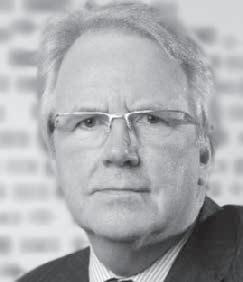
1 Curie v Mornington Peninsula Shire Council [2022] VCAT 1052.
2 Ibid.
VPELA Revue March 2023 / 29
https://www.instagram.com/vpela_ Follow us on 29
Rory Costelloe, Executive Director, Villawood Properties

Housing affordability
We’re facing uncertain economic times right now, but it is interesting to know the old principle of early economist Adam Smith (from my year 11/12 textbooks) still applies: supply should equal demand. So, if you can’t satisfy demand with supply, then demand drives prices up, and the reverse scenario will drive prices down. The Reserve Bank has certainly halted current demand by inducing a recession this year led by interest rates.
Our current over-governed economy, however, is so complex that there are myriad other factors standing between us and housing affordability. The biggest encumbrance to supply right now is, in fact, planning.
You may think this is a brave thing, raising this issue in a VPELA article for planning professionals. But the Planning and Environment Act 1987 created the prominence of a planning profession whose idea of well-planned cities is sound and noble, but which has become somewhat lost in over-regulation that is severely restricting supply. This over-regulation applies to the inner, middle and outer rings of Melbourne.
Melbourne CBD
Places Rory’s Ramble 30
In the CBD, we’ve seen a proliferation of building activity somewhat halted by the abolition of the off-the-plan stamp duty exemption. Subsequently, there’s now no incentive for a buyer to buy off the plan. Buyers might as well wait for the finished building, but banks won’t fund construction without 100% pre-sales of construction costs. With the current absence of international investors and students, CBD prices are still affordable. But once the students return, they’ll become unaffordable again. I believe we should reintroduce off-theplan stamp duty exemptions for Australian citizens to encourage owner-occupiers and local investors into the CBD market.
Then there are also new minimum standards for apartments which have slowed developers’ appetites to build. And probably rightly so, incidentally, as there were some pretty poor plans being fed to buyers.
Inner and middle-ring suburbs
The basic principle of planning is that all growth, in any city, should be managed within the existing available infrastructure, where possible.
Melbourne is presently severely restricted in its inner growth due to Neighbourhood Character Overlays (NCOs). These have starved the opportunities for small four, six and eight-pack unit and townhouse developments throughout Melbourne and regional Victoria. There are tens of thousands of sites that have been prevented from obtaining planning approval due to NCOs over the last decade or so. Third-party appeal rights have also severely affected planning permit processing, both in timelines and success. The NIMBY attitude is stifling progress, particularly for any affordable or social housing projects.
Inner Melbourne has been restricted to specified activity centres, but the planning process is so slow – and the sites are owned by so few, that the land prices are exorbitant and there’s no hope of achieving affordability.
Outer-ring Melbourne
The growth corridors have traditionally provided Melbourne with the affordability factor, where a new house and land package is affordable at 60% of the average established Melbourne house price.
Supply here is also being more and more restricted as the Precinct Structure Plan (PSP) system is dragged out over many years and planning permit conditions have ballooned from a dozen conditions to almost 200 conditions.
Another factor in the lack of supply is that as house prices go up, farmers want astronomical amounts for the raw land. This, in turn, dramatically increases the cost of Infrastructure Contributions Plans (ICPs) since the dominant factor of ICPs is land price.
The price of a block of land in Melbourne 10 years ago was $195,000. When we had a huge increase in population growth in the late 2010s, we saw a massive surge in house prices. Then again, during Covid, the introduction of the $25,000 HomeBuilder Grant, plus First Home Owners Grant and stamp duty exemptions sent the market into a frenzy with land prices skyrocketing to over $400,000.
Melbourne’s average outer growth sale rate is normally 15,000 lots per year. 18 months ago, it spiked to 30,000 lots, which the land and building industry has been unable to cope with, sending prices spiralling. This year, the industry will be lucky to sell 8,000 lots, so hopefully we will see prices drop – but some developers and builders are already going broke in the process.
Regional Victoria
Affordability exists in the regional towns. The price of a block of land is directly proportional to the distance of travel to Melbourne, for example a 448 sqm lot in Melbourne is $480,000; Geelong $420,000; Ballarat $350,000; Bendigo $260,000. Existing house prices are also proportionally lower.
I was born in Melbourne, lived in Bendigo for 30 years and have now been living in Geelong for 20 years. Regional towns offer a wonderful lifestyle, but this may be short-lived with the pending Windfall Gains Tax (WGT) starting in July. WGT is totally disproportionate, particularly as the income goes to State general revenue, unlike Growth Area Infrastructure Contribution (GAIC), which is supposed to be spent on trains and arterial roads to growth areas. The WGT should be replaced with a regional GAIC to be spent on regional infrastructure, not general revenue.
The introduction of distinctive areas and landscapes (DALs) also reduces opportunities to live in regional Victoria. This is one of the biggest dangers, particularly as, once they are adopted, it takes both Houses of Parliament to change them. And since there are so many minority parties in the Upper House, these lockdowns may last forever. After Panel Hearings in the Surf Coast and Bellarine, Government has ignored the independent recommendations and installed DALs irrespective as vote winners. They are already in Mornington and Macedon Ranges… and maybe Bass Coast next. Planners need to be careful what they wish for, as DALs will spread across the State like NCOs did, and further constrict our future housing opportunities.
30 / VPELA Revue March 2023
Planning and unaffordability
The aim of the State and Federal Governments’ Big Build is to spend billions on much-needed houses to be offered at 25% less than market rent. But imagine if prices had not risen 50% in the last three years. We would not have this critical unaffordability. If we’d had adequate supply to meet demand, developers and speculators would not have had the opportunity to push prices, avoiding our present problems.
Other factors add to unaffordability. After the Banking Royal Commission in 2018, the majority of property finance is now done by non-banks. The Australian Prudential Regulation Authority’s aim to have more control over banks has backfired, as non-bank lenders are unregulated and significantly add to the cost of doing business.
It is also important to note that there are certainly some bad eggs among developers and landlords, but some of the rules to control their bad habits have had a negative effect on supply and on affordability. For example, the introduction of mandatory fire alarm inspections and other regulations that require engaging consultants have added to the costs of owning and developing rentals. They are needed for safety, but have an unintended cost consequence. So, some landlords have voted with their feet and decided to get out of rentals. Agent’s fee, insurance, compliance, land tax, OC and maintenance can easily consume over 40% of rent.
Due to rapid price rises over the last five to six years, a lot of landlords found it more attractive to take a profit and sell their home to an owner-occupier, dramatically reducing the rental pool in the process. Even in holiday accommodation, these rising prices have prompted many people to put their rentals for holidaymakers on the market. They’ve then sold these properties, as city dwellers have fled the city for their ‘tree and sea changes’ in our new Zoom/Teams workplace society.
Anna Cronin ran the Red Tape Commission some years ago and developers are still waiting for a lot of those findings to be implemented.
The PSP process needs to be sped up, with strict exhibition timelines. Sometimes the VPA is looking for perfection, which can be too slow and doesn’t necessarily improve the outcome. There should be an ability to exhibit planning amendments whether supported by Council or not, then the decision can be umpired by planning panels.
So, in summary, the broad end supply solutions are to:
Reintroduce off-the-plan stamp duty exemptions for high and medium-rise buildings in the CBD and inner ring, but only for Australian buyers.
Dramatically unwind the NCO provisions for the middle ring, even if this seems nigh on impossible given Save Our Suburbs has such a strong voice.
Uncomplicate and speed up the PSP and planning permit processes for the outer ring.
Be brave and reduce third-party appeal rights to prevent NIMBYism.
Understand we all want quality housing choices. The current stifling of progress is pushing housing costs beyond our reach.
Replace WGT with a regional GAIC.
Of course, the other solution for affordability is to simply have a recession that brings everyone back to earth. The Reserve Bank is determined to increase interest rates to dampen the economy and bring us to another recession we ‘have to have’. Unfortunately, however, those who will suffer the most are those who can least afford it – the low-income earners. In turn, this leads to desperation, crime and domestic violence as the gap between the haves and havenots gets bigger.
I understand it’s an incredibly complex global economic stage we’re part of, but above are some of the simpler topics contributing to the problem of housing affordability – and they’re all things that we can control.
Rory Costello, Executive Director, Villawood Properties
YPG Speed Networking
VPELA Young Professionals Group kicked off its 2023 calendar with the annual Speed Networking event. The ever-popular event saw a great turnout from a range of disciplines and industry sectors, and we were delighted to have a number of students join us as they look to transition into the industry in the years ahead.
The evening was a great success with many new relationships forged and old friends connecting. Continuing its great history, the event created further links and networks within the industry that will no doubt be the foundation for friendships in years to come.
Our special thanks go to our 2023 YPG sponsors, Biosis, Contour Consultants, Taylors Development and Traffix Group, and our host for the night, Tract. Its office and outdoor space had us enjoying the perfect venue.

We look forward to seeing you at our next event!
James Cossins is a Senior Traffic Engineer at Traffix Group
VPELA Revue March 2023 / 31
31
YPG Speed Networking 32

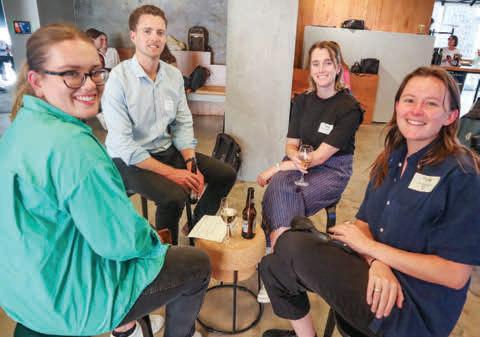
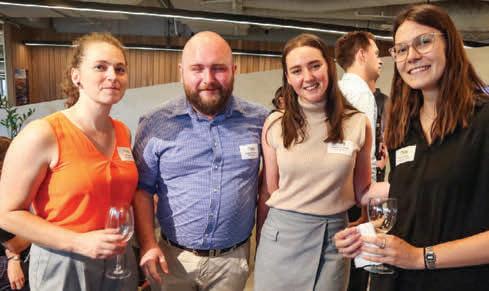
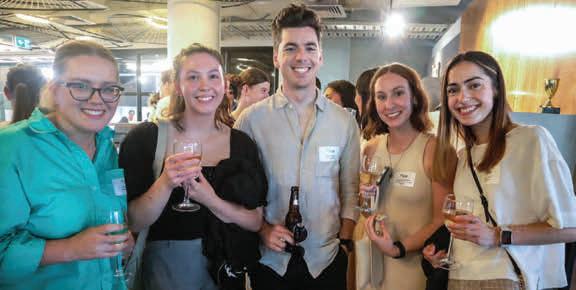

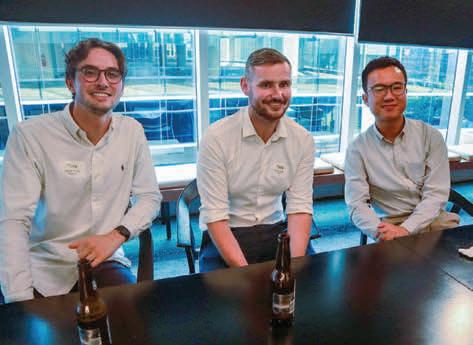
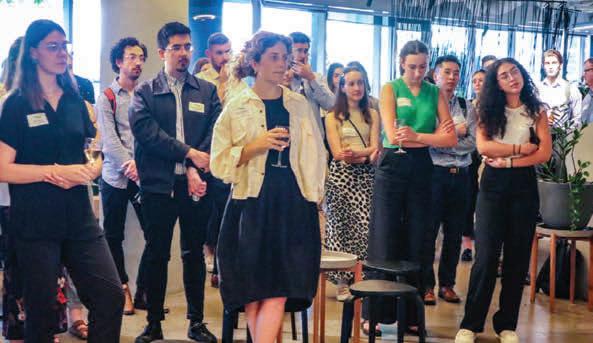
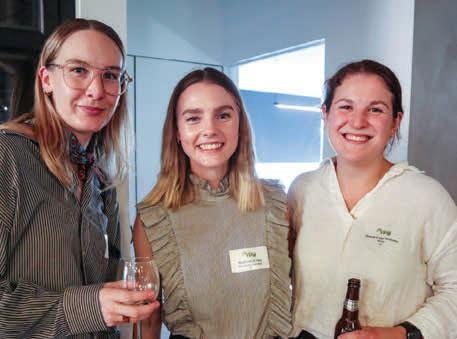
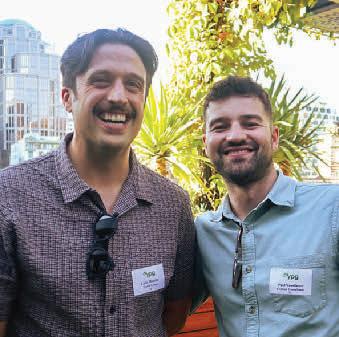

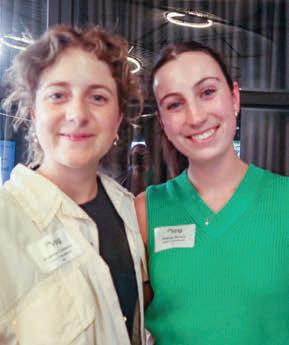
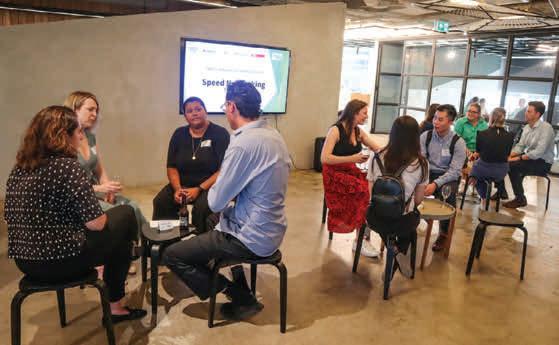
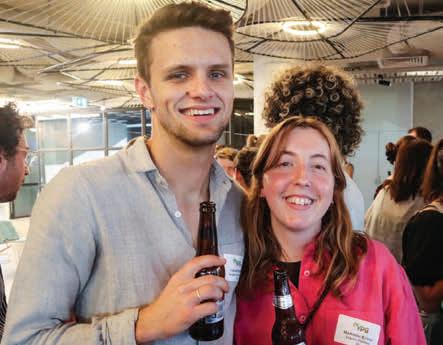
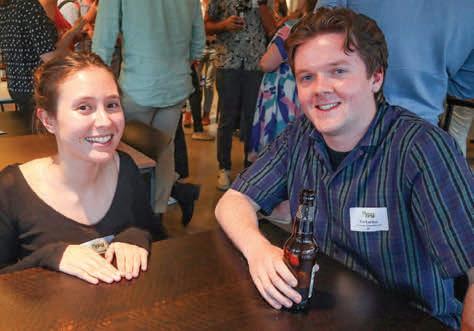

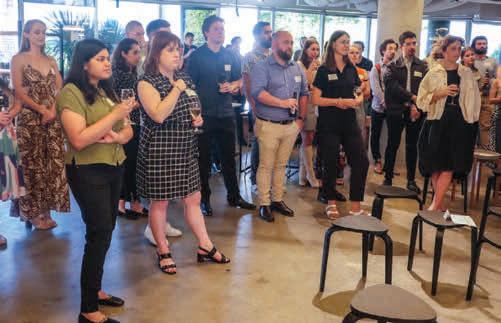
Established



– A MULTI-DISCIPLINARY PROFESSIONAL ASSOCIATION
VPELA
PO Box 1291 Camberwell 3124, 9813 2801 www.vpela.org au
in 1989, the Association holds regular seminars, social events and a conference annually. It also reviews legislation, provides high level advice to Government and makes submissions to all aspects of land use planning. If you have any questions or are interested in joining the Association, contact Anna Aughterson, Executive Officer – admin@vpela.org.au






















































































































































 Tom Morrison, Lawyer, Planning & Property Partners
Tom Morrison, Lawyer, Planning & Property Partners










 Senior Partner
Senior Partner

 Special Counsel
Special Counsel



















